Chapter 10 Biodiversity Environmental Crisis And Conservation Of Endangered Animals Forest
Conservation Of Plants And Animals
Forests are vital to the survival and well-being of people everywhere all 7 billion of us. Forest is the wide range of land area occupied by plants. Forests are the dominant terrestrial ecosystem of Earth and are distributed across the globe. Nearly one-third of the earth’s land (33%) area is covered by forest. Forest is the home of 80% of our terrestrial biodiversity.
According to World Bank estimation, more than 1-6 billion people depend on forests for their livelihood and some 300 million live in them. The forest product ‘ industry is a source of economic growth and employment. Forest cover 21% of the total land area of India.
Read and Learn more WBBSE Notes For Class 8 General Science And Environment
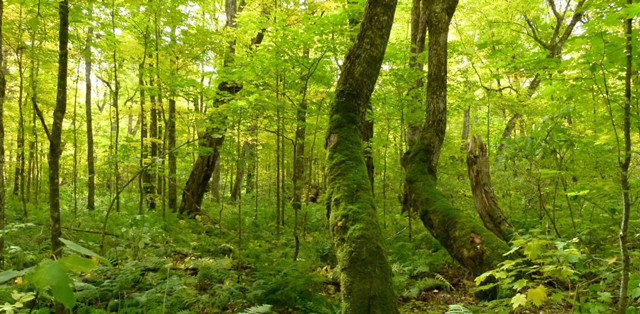
- Forestry: A branch of science which deals with different aspects of the forest.
- Silviculture – Branch of forestry dealing with cultivation and raising of forest plants.
- World forest day-March 21st
However, the total global forest area has started to shrink at an alarming rate.
- Global forest area-33%
- Indian forest area-21%
- West Bengal forest area-13-38% Forest area decreased worldwide – 0-22% per year. (1990-2000) and 0-18% per year between 2000 – 2005
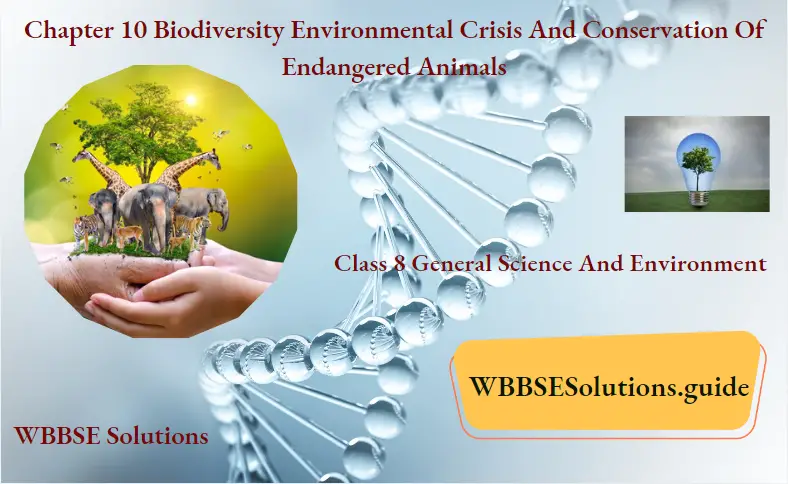
Chapter 10 Biodiversity Environmental Crisis And Conservation Of Endangered Animals Benefit Of Forest
- Control weather
- Reducing air temperature. Maintain hydrological cycle. The water cycle, rainfall and wind flow.
- Prevent soil erosion.
- Plants and their root system serve as living filters and reduce the contamination of groundwater.
- Protecting from dust pollution, evergreen trees have higher efficiency of removing air pollutants.
- Control underground water level.
- Source of wood
- Source of fuel.
- Source of different drugs.
- Maintenance of Eco-system.
- Maximum Biodiversity occurs in the Amazon rainforest (52% of world Biodiversity).
- The Amazon rainforest has been described as the lung of our planet as Sundarban of Kolkata.
| Class 8 General Science | Class 8 Maths |
| Class 8 History | Class 8 Science LAQs |
| Class 8 Geography | Class 8 Science SAQs |
| Class 8 Maths | Class 8 Geography |
| Class 8 History MCQs | Class 8 History |
“WBBSE Class 8 General Science Chapter 10 notes, Biodiversity Environmental Crisis and Conservation of Endangered Animals”
More over we use more than 5000 forest products in daily life directly or indirectly. It has been estimated that a tree lives for about 50 years it emits 2700 kg of oxygen in its 50 years lifetime. ‘ If you observe two localities near the forest and far from the forest you will get a clear idea about the benefits of the forest. Makg a table of these benefits.
Make a list of your daily use articles and find out its plant source :
| Articles | Plant products | Sources |
| 1. Pencil | ||
| 2. Scale (wooden) | ||
| 3. Eraser | ||
| 4. Dress/clothes | ||
| 5. Medicine | ||
| 6. Food products | ||
| 7. Mat | ||
| 8. Hand fan | ||
| 9. Threads | ||
| 10. Fuel | ||
| 11. Sitting arrangements |
Chapter 10 Biodiversity Environmental Crisis And Conservation Of Endangered Animals Types Of Forest
Types Of Forest:
Broadly there are three major forest zones. They are separated to their distance from the equator.
1. Tropical forest:
Near the equator having the greatest diversity of species. It has two distinct seasons rainy and dry no winter. Soil is nutrient poor and acidic. Rainfall 200 cm or more, temperature 20-25°C. Canopy in tropical forests is multilayered and continuous, allowing little light penetration.
Trees are mostly evergreen with large dark green leaves. Different types of birds, bats, small mammals and insects are the main animals.
2. Temperate forest:
Forest in between pole and equator. Temperate forests have well-defined seasons with distinct winters. Temperature -30°Cto 30°C, rainfall 75-150 cm. Soil fertile enriched with decay litter. The canopy is moderately dense and allows light to penetrate. Flora-oak, hickory, beech, maple etc. Fauna – squirrels, tigers, lion, deer, birds, etc.
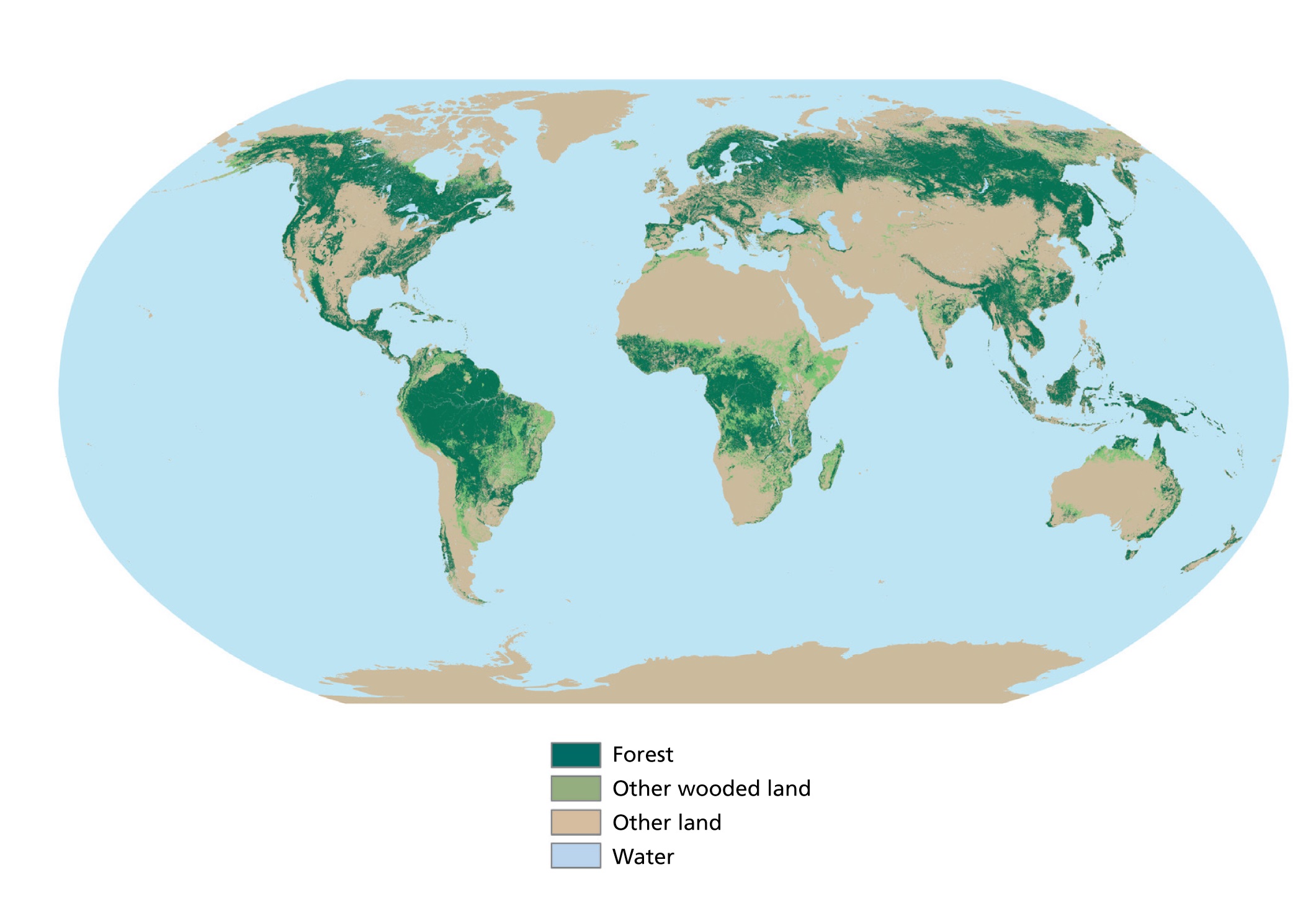
3. Taiga or boreal forest:
Present near the pole. Seasons are too short, and moderately warm summer and long cold and dry winter. Temperature are very low, rainfall 40-100 cm, and soil nutrient-poor and acidic. Canopy permits low light penetration, so the understory is limited.
“Class 8 WBBSE General Science Chapter 10 notes, Biodiversity and Environmental Crisis study material
Flora-cold tolerant evergreen conifers with needle-like leaves-pine, fir. Fauna – wood packers, hawks, moose, bear, fox, wolf, deer, hares, shreaws, bats etc. very few reptiles. There are also some more specific types of forests within these larger regions.
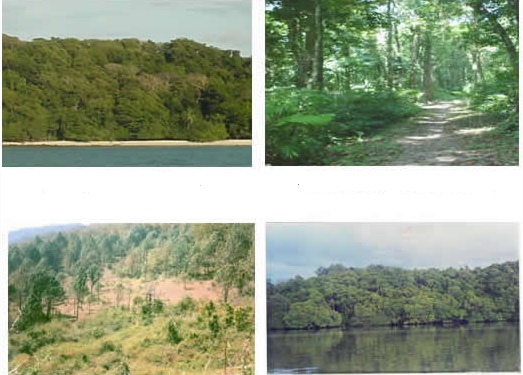
- Evergreen: Rain throughout the year no dry, season. Maximum bio-diversity is found here and its productivities are maximum.
- Seasonal: Vegetation evergreen, having a short day season.
- Semi-evergreen forest or Dry forest: Having a long dry season in which trees lose leave
- Mentone (cloud forest): Mostly conifers.
Chapter 10 Biodiversity Environmental Crisis And Conservation Of Endangered Animals Types Of Forest And Their Role
Several types of forests are found in different geographical areas and this is due to changes of climate. Among the total forest area, 95% is natural forest and 5% is cultivated forest. South America covers 23% forest area while Oceania have 5%. Forest plants with needle-shaped leaves are—Pine and oak.
The tropical rainforest has more kinds of trees than any other area, distributed near the equator. 10 countries of the world have no forest area and another 64 countries have less than 10% forest area.
Amazon rainforest –
The Amazon river basin rainforest contains a wider variety of plant and animal life than any other biome in the world.
| Forest type | Forest-plant leaf | Plant | Animals |
| Conifer/Taiga | needle-shaped leaves | Pine, oak | Black bear, Leopard, owl |
| Deciduous forest | normal leaves shaded periodically | Teak, Shal, Arjun, Amloki | Tiger, Bison, Elephant |
| Evergreen forest | Normal green leaves, plants having leaves throughout the years | Mango, Banyan, Rose, Apple | Tiger, Deer, Peacock Monkeys. |
| Bushy Desert / Dry area forest | Thorny bushy plant | Babul, Cactus | Blackbuck, Jackal, reptiles |
| Savana—grassland | Grass with long leaves | Different types Purundi | Rhinoceros, Deer, Zebra of grass, Hogla, |
| Mangrove forest | breathing roots and glossy green leaves | Goran, Gewa ‘ | Tiger, Deer, Pig, Crocodile |
Below there are some plants and animals choosing from list of 3/4 food chain, mentioning producers, consumers – (herbivores and carnivores)
| Grasshopper | Grass | Tiger | Banyan |
| Grass | Eagle | Leopard | Bear |
| Toad | Hare | Fish | Oak |
| Snake | Jackal | Otter | Pine |
| Peacock | Rhinoceros | Mongoose | Bat |
| Earthworm | Termites | Crab | Squirrel |
| Bamboo | Owl |
Chapter 10 Biodiversity Environmental Crisis And Conservation Of Endangered Animals Structure Of An Ideal Forest
Components of the forest :
Evergreen forests such as the Amazon rainforest and the tropical rainforest consist of many components divided into two categories that are living or biotic and non-living or abiotic factors.
“WBBSE Class 8 Science Chapter 10, Conservation of Endangered Animals study guide
Biotic components include trees, shrubs, vines, grass and other herbaceous (non-woody) plants-mosses, algae, fungi, microorganisms, and different types of animals. Abiotic factors are humidity, sunlight, wind, rainfall, soil, etc.
Chapter 10 Biodiversity Environmental Crisis And Conservation Of Endangered Animals Layers Of Forest
If you notice the plants in the forest you will find plants are of different lengths. Therefore, different layers are formed. In a typical forest, there are four layers such as- tropical forest flora and fauna are highly diverse. One square kilometre may contain 100 different tree species.
1. Emergent layer:
The uppermost layer of tropical rainforest. Tall trees reach the level and spread out usually with the straight branch, and free trunks with crowns on the tops. They are about 100 ft. to 200 ft tall with supporting buttress roots spread up to 20 – 30 ft.
Trees have small pointed leaves this type of adaptation for speedy wind. Animals found in this layer—are bats and birds.
2. Canopy:
The second upper layer below the emergent layer is 100 ft and below that. It is the thickest layer of forest usually form the roof of the forest. The Canopy is the layer that stops sunlight and rainwater from getting to the layer below it.
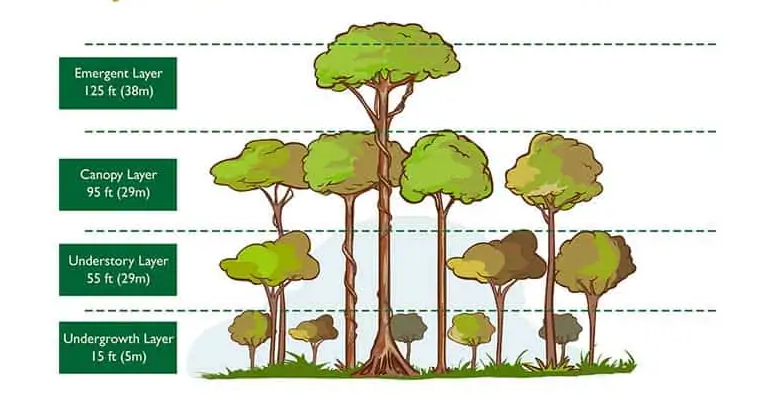
Canopy is formed by the mass of intertwined branches twigs and leaves of the mature trees forming the crown of the forest getting most of the sunlight. It is the most productive part. Some rootless plants grow in this layer also.
Canopy is the cover formed by the leafy top branches (roof) of the tallest trees in the forest. Millions of insects and other animals are present in this layer as they have enough food to keep them there. Common animals include squirrels, monkeys, reptiles, bats and a variety of birds and tree dwellers many mammals also present there.
3. Understory:
Below the canopy is made up of bushes, shrubs, and young trees. (12 ft. upto) they are adapted to live in the shades. This layer has many vines, dense vegetation but not much sunlight reaches here, it is blocked by the canopy layer. Animals like small birds, frogs, beetles, termites, snakes, butterfly etc. This part is wet and humid dark in nature.

4. Forest floor:
The ground layer is dark, and damp and contains decomposing leaves, animal droppings and dead trees. Different types of ferns, moss, mushrooms and other fungi and tree seedlings grow here. Large mammals like tigers, elephants etc. frogs, toads, lizards, and insects, are the common animals. Animals that are found here both herbivores and carnivores.
Conservation Animals
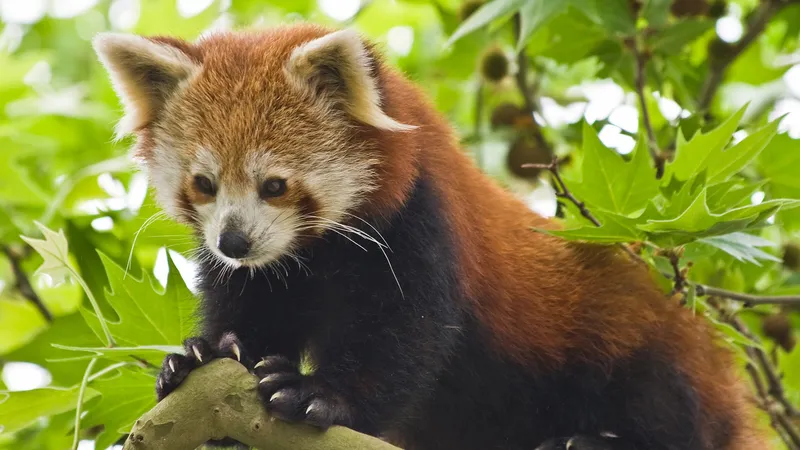
They include scorpions, armadillos, wild cats, mongooses, lizards and a variety of insects. The tropical rainforest has more kinds of trees than any other area in the world. 70% of the plants in rainforests are trees. Thundershowers on an average occur 200 days out of 365 days in a year, in the tropical rainforest creating a very humid atmosphere.
“WBBSE Class 8 Biodiversity and Conservation notes, General Science Chapter 10”
The trees of tropical rainforests are so densely packed that rain falling on the canopy can take as long as 10 minutes to reach the ground. The first forests were dominated by giant horsetails, club mosses, and ferns that stood up to 40 feet tall nearly 38 million years ago.
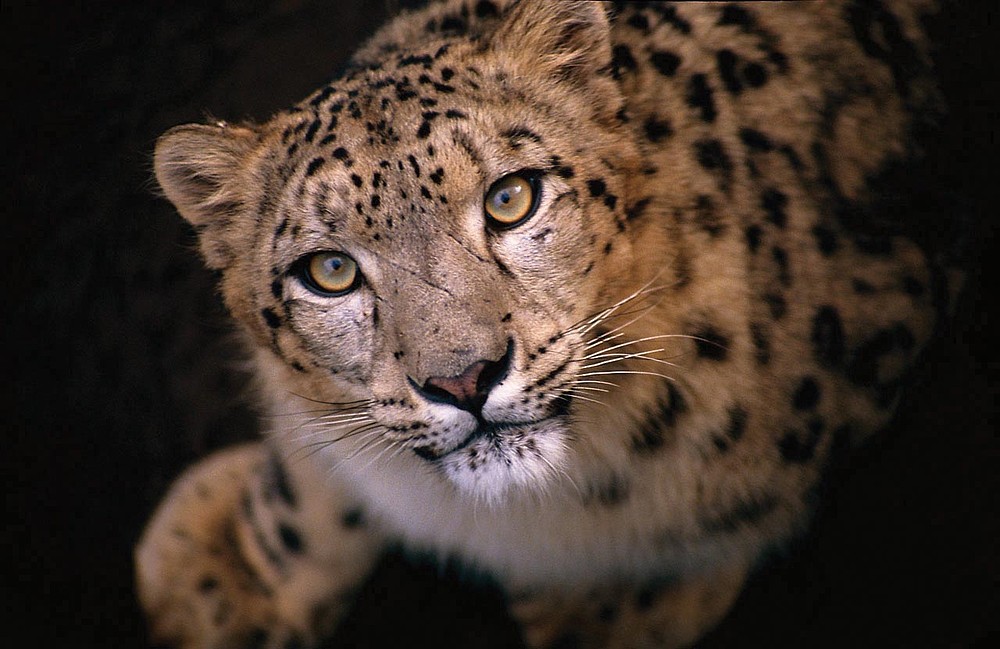
Boreal forests (= Taiga) can be found in the broad belt of Eurasia and North America. Two-thirds in Siberia with the rest in Scandinavia, Alaska and Canada. Taiga covers 11% of the earth’s land area.
Loss of forest :
We destroy 130000 sq. km of forests every year. Rainforests once covered 14% of the earth’s land surface now they cover a mere 6%. More than half of tropical rainforests have already been destroyed.
Deforestation :
It is the removal or decrease of deterioration of forest cover of an area. Indian forests comprise nearly 1% (one) of the world’s forest area, India is losing about 1.5 million hectares of forest cover each year.
Chapter 10 Biodiversity Environmental Crisis And Conservation Of Endangered Animals Forest Facts
- About one-third of the world’s land area Is covered by forest;
- Forests have to 80% of the world’s terrestrial biodiversity.
- Rainforests are responsible for the production of over 40% of the world’s oxygen.
- Around 1-6 billion people around the globe depend on forests for their livelihood.
- The giant sequoia tree of North America is considered to be the tallest living tree on the planet growing incredible heights of 95 metres.
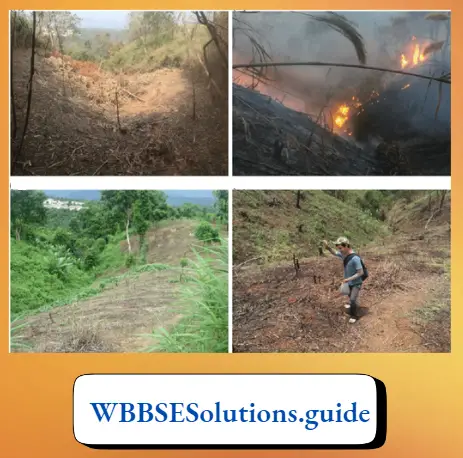
Causes of deforestation :
Deforestation is mainly due to the following reasons-
- Fire, mining, urbanization
- Road and dams construction
- Agriculture
- Cattle ranches
- Certain changes of climate
- Illegal cutting of trees
- For Human establishments of different things like factories, new farms etc.
A forest fire and its damage :
A forest fire is an uncontrolled fire that occurs in a forest area. Forest fire is one of the causes of loss of the natural habitat of plants and animals. About 1% (one) of forests roughly the size of New Zealand are consumed by fire each year. Nowadays most forest fire are caused by humans.
Factors responsible for forest fires are —
- Volcanic eruption when come in contact with dry twigs or branches of the tree.
- Volcanic lava.
- Lightning strikes.
- Frictions between twigs or trunks of different trees.
- Human activities
Damage caused due to forest fire :
- Loss of plants decreases 02 concentration in this area and increases the concentration of C02 leds to an increase of the temperature of the environment (global warming)
- The soil of the forest retains rainwater.
- Due to loss of trees water cannot be retained anymore by the soil.
- Soil erosion causes due to lack of grifting of roots.
- Loss of a large number of valuable plants and animals.
- The balance of the ecosystem of forests is seriously hampered.
- The water cycle (water-cloud-rain —> ice) gets disrupted.
- Extinction of rare or endangered species loss of biodiversity.
Forest conservation :
Forest conservation is the protection, restoration and preservation of forests.
- The trees cut down for timber or other uses, should be balanced by planting of more trees so that there is no scarcity.
- The use of wood as fuel and wood charcoal should be discouraged. The use of alternative fuel should be encouraged.
- The adequate measure should be taken to check the spread of disease of any tree in the forest and forest fire should be controlled.
- Modern forest management programmes should be adopted.
- Afforestation and reforestation should be taken.
The development of forests in the denuded region is called reforestation and the creation of forest over the base area is called afforestation. Forestation is must for slopes and hills. In West Bengal forest arear nearly 13-38%. Among them, two main forest areas are the Forests of North Bengal and the Mangrove forests of Sundarban
Chapter 10 Biodiversity Environmental Crisis And Conservation Of Endangered Animals Crisis Of Forests Of North Bengal
West Bengal has a forest cover of 1-19 million hectares much of which is in the Darjeeling and Dooars region.in North Bengal. There is a tiger reserve in the region known as Buxa Tiger Reserve (BTR) wildlife sanctuaries at Jaldapara and Mahananda National Park, Gorumara, Neora Valley and Sangalila.
The forests of North Bengal have rich diversity of flora and fauna. Sal occupies nearly 80% of all vegetation in the tropical forest other plants are Gamhar, Odal, Khair, Sishu etc. and different types of orchids are found here. A variety of mammals, reptiles, and rare species of trees are found.
Besides the one-horned Rhinoceros, The fauna of the area includes the Asian elephant, Gour, Leopard, and Deer. The vegetation changes with altitude in North Bengal. The plains of the foothills are covered by sal, as soon as the altitude increases vegetation changes in the higher altitude region. Rhododendron, Magnolia, Oak, Hemlock, Silver Fir, different types of bamboo, etc.
“Class 8 WBBSE General Science Chapter 10, Environmental Crisis and Conservation easy explanation”
Ferm’s wild grasses are common. Several tea gardens have been set in this area. In the cool climate rare species of mammals like red panda, Snow leopard, Gour, Elephant, Himalayan Black Bear and different types of birds are found here. In Jaldapara endemic species of Rhinoceros (R unicorns) is found. Now the forest and adjacent area faces different types of problems.
The forests of North Bengal is an extremely rich biodiversity zone but today face a declining Rhino-population and much vegetation. There have been repeated incidents of elephant and Bison death on railway tracks running through the forest of North Bengal.
Most of the cases has been reported from a 100 km stretch of railway track between Alipurduar to Siliguri. The track was converted to. broad gauge line in 2004, allowing an increase in train number and speed, illegal cutting of trees also decreasing the forest area.
Chapter 10 Biodiversity Environmental Crisis And Conservation Of Endangered Animals Man And Elephant Conflicts
Last 50 years population of this area has been increased rapidly. So more and more human villages or habitations have been established and some new Tea garden has also been established or old one extended their area. All these decrease the forest area. Thus the Natural ecosystem is hampered.
In some cases, corridors of elephant passing have been obstructed by developmental work. For this reason, the man and elephant conflict has been started. Death of many elephants have occurred in railway tracks. Elephants sometimes attack human villages and crop fields due to scarcity of food.
Paragraph On Conservation Of Plants And Animals

Not only elephants, leopards, tigers, rhinos, Gour, and Bison are also killed in the conflict. To solve the problem forest department has increased the core and buffer area of the forest. Some elephant corridors has been set up to control the elephant attack. , Incidence of infestation of other wild animals such as Leopard, Bison, also a problem. The scarcity of food is the main reason.
The scarcity of wild natural prey of leopards, change their food habits they are now more and more dependent on capturing goats, cattle, ducks, hens, poultry birds etc. This creates another conflict. Tea Garden labour is sometimes attacked by leopards. In fear, people attack them and killed them.
“WBBSE Class 8 Science Chapter 10 notes, Biodiversity and Conservation PDF”
General awareness to be raised against these killings. Sometimes elephants migrate from other places’ neighbourhoods (Dalma Hills) and refuse to return their native place. These create also problems.
Mangrove forest and their present Crisis :
A mangrove is a shrub or small tree that grows in coastal saline and brackish water. Mangroves occur worldwide in the tropics and subtropics. Mangroves are salt-tolerant trees also called holophytes and are adapted to life in harsh coastal conditions. Mangrove forests are found in the southern tidal areas of West Bengal.
Sundarban forest is mainly a mangrove forest. They contain a complex salt filtration system and a complex root system to cope with saltwater immersion and wave action. They are adapted to the low oxygen conditions and water-logged mud. Mangrove plants have respiratory roots and many of these plants have stilt roots.
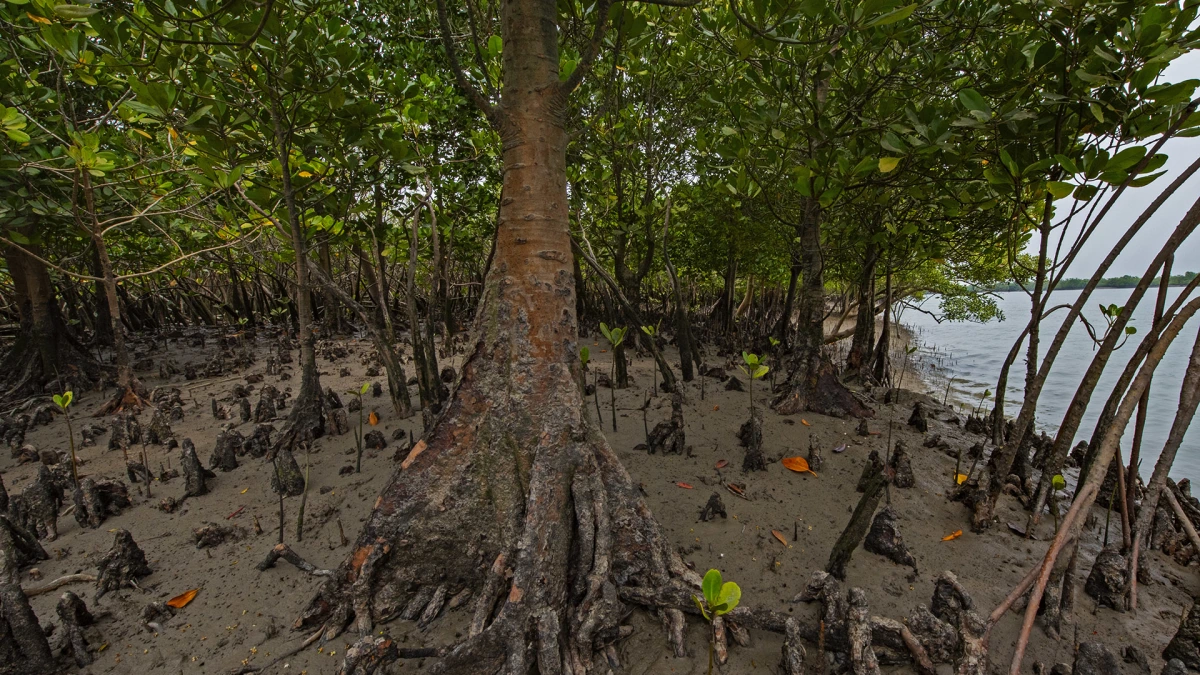
Respiratory roots, the upward-directed root branches with pores (pneumatophore) helps them to continue their breathing of roots in muddy or water-covered condition. Stilt roots help them to attach with the soil that not extirpated the plant during high tide.
The lower part of plants like the base of mangrove plants like Byne, Keora, Pasur, and Garan became submerged twice under water during high tide. Some mangrove plants (Rhizophora species) Garjan, Garan, Kanura and same other seeds germinated inside the fruit before falling to the soil.
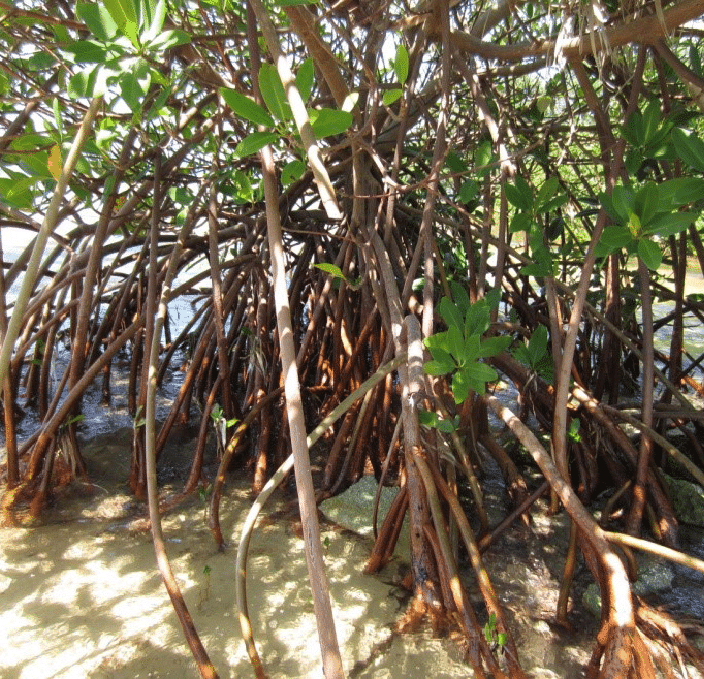
This is due to avoid germination in saline water where they may wash out by tidal water. This type of germination is known as viviparous germination.
Chapter 10 Biodiversity Environmental Crisis And Conservation Of Endangered Animals Problems Of Mangrove Plants Of Sundarban
1. Nowadays due to the deposition of silt in the river basin of different rivers going through this mangrove forest and due to the raise of the sea-water level the water level raise and more marine water flow inside rivers therefore, the salinity of water of this area raise.
This comparatively high saline water (33 – 38 gm / 1000 gm marine water) enters inside the creeks directly. Plants of terrestrial lands are unable to tolerate more salty water. Excess salt cause toxicity in the tissues of plants.
“WBBSE Class 8 General Science Chapter 10, Biodiversity Environmental Crisis important questions”
Plants try to eliminate excess salt through leaves and roots but still they face problems and rise of water levels in creeks (Khauri) causing soil erosion. Roots unable to hold the plants. Some plants loss in this process.
Water and soil pollution, increase water temperature and some unwanting substances from manure and pesticides cause serious damage to the flora and fauna living in this water.

“Class 8 General Science Conservation of Endangered Animals notes, WBBSE syllabus”
Crocodiles, Turtle and tortoises, crabs, and fishes are under severe threat of extinction. Excessive tourism in this area also causes pollution and damages the ecosystem of this area.
Observation-
Visit this place as much as you can. Identify the plants their and animals as much as you can. The people around this area their activities. Note down the problems.
Chapter 10 Biodiversity Environmental Crisis And Conservation Of Endangered Animals Life Under The Sea
Many of you have seen and may have collected different types of molluscan (snail) shells, starfish, Jellyfish, octopus, and some hard whitish sleeper-like internal skeletons of Sepia during the walk along sea-shore. Let’s see what is the sea and its environment and biodiversity ar.
The Ocean (sea) is a continuous water mass covering about three-fourths (75/£) of the earth s surface. Most oceans are deeper than two kilometres and are home to some of the most diverse life on the earth.
We are familiar with animals that live on the surface of the ocean where sufficient light penetrators and photosynthesis take place in plants. Where large quantities of diatoms and other phytoplankton are present and they give colour to the sea.
Phytoplankton-
They are small and mainly microscopic. They can produce their food by photosynthesis with the help of sunlight, for example. diatoms, dinoflagellates, blue-green algae etc.
Zooplankton-
They are unable to produce food and feed on other plankton, for example, larval forms of different arthropods, shrimp, krill, etc.
The photosynthetic micro-floating organism is called phytoplankton. These are mainly algae. These are the main sources of food of zooplanktons and many others sea dwellers. Phytoplanktons and some algae-like plants mainly occupy the lighted water column of the sea.
If we go deep down the sea, we will notice the sunlight is gradually dimming (waning) and if we go further down it is pitch dark. The majority of sea dwellers (animals) live in the upper part (surface zone) and gradually their number decreases as the increase of depth and their structural and behavioural patterns also change.
The deep sea zone where living conditions not at all favourable very few types of animals are found there. The pressure there is so immense that we would be crushed if we go down there. The temperature is nearly freezing, food is very scarce and there is no light at all.
Chapter 10 Biodiversity Environmental Crisis And Conservation Of Endangered Animals Plankton
A small mainly microscopic diverse collection of aquatic organisms which are unable to swim against the water current drifting or floating in the sea or fresh water. Planktons are mainly diatoms, protozoans, small crustaceans (arthropods) and the eggs and larval stages of larger animals. ‘These are the food sources of many aquatic animals including fish and whales.
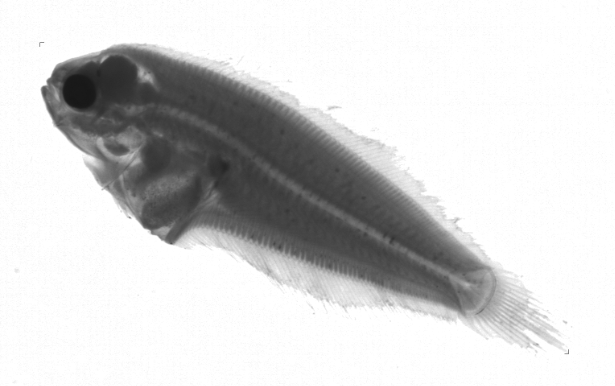
Planktons are of two types
- Phytoplankton and
- Zooplankton.
Chapter 10 Biodiversity Environmental Crisis And Conservation Of Endangered Animals Oceanic Depths And The Conditions There
Ocenographers divide the open ocean (pelagic /one) into five layers.
1. Sunlight zone
The first layer (epipelagic /one) Oceanography extends up to 200 metres (600 ft) It is the photic j It is the study of different aspects zone or sunlight zone that receive sunlight.
Phyto planktons, zooplanktons and some other animals like Jellyfish, many sharks, dolphins many fishes, (clown fish) f Blue whale feed on plankton, are formed in this zone.
Oceanography
It is the study of different aspects (biology, physics, chemistry, geography, engineering and metrology) of the ocean.
2. Twilight or Dimlight zone (mesopelagic zone)—
The second layer extends from 200 metres to 1000 metres. The intensity of light is low so this layer is known as dim light or twilight zone. Submarines usually use this layer Animals that live here are swordfish, squid, wolffish, and some cuttlefish, whales.
Many organisms that live in this zone are bioluminescent. Some creatures of this zone move to the upper zone at night to feed. The eyes of fish are larger and usually directed upwards, probably to see other animals and for food against the pale light.
3. Midnight zone (bathypelagic zone)—
This is the third layer extending from 1000 metres to 4000 metres. The sunlight doesn’t penetrate deep into this layer. The ocean is pitch black. So this zone is known as the midnight zone. No living plant exists here.
Most animals living here survive by consuming the detritus failling from the zone above. Animals living here are Angler¬fish, Squids, giant squids, octopus, sperm whales, etc.
4. Lower midnight zone or Abyssal zone (abyssopelagic zone)—
This is the fourth layer extending from 4000 metres to the sea floor. No light, immense dark the pitch-black bottom layer. The water here is almost freezing and its pressure is immense. Very few creatures live in this zone.
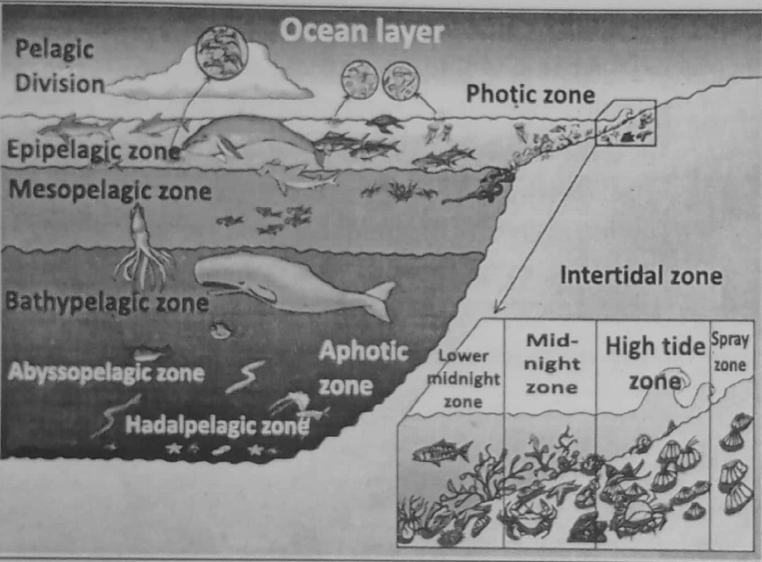
Animals found in this zone are squid, many echinoderms, marine arthropods, and sea spiders. Many of the species living at these depths are transparent (no pigment) and eyeless because total lack of light in this zone.
5. Hadalpelagic zone-
The zone includes water found in the ocean’s deepest trenches. This zone is mostly unknown. However, some organisms live in hydrothermal vents.
Chapter 10 Biodiversity Environmental Crisis And Conservation Of Endangered Animals Diversity Of Life In Different Regions Of Sea
Many living sea organisms are found in the space created in the water level during low tide. The organisms are usually found in algae, snails, mussels, starfishes, sea anemones, crabs etc. Sponge and some other animals fixed themselves with sea bottom and rocky substances. ‘
Phytoplanktons and zooplanktons are usually found near surface common fishes, the octopus whales, eels and squid are found in middle areas, starfish various worms, snails, and oysters are usually bottom dwellers. The intertidal area (= littoral zone) is where the land and sea meet; between the high and low tide zones.
This area is rich in nutrients and oxygen and is home to a variety of organisms. In this area (high, middle and low tide area) sea anemones, chitons, crabs, green algae, mussels, snails, sea cucumbers, sea stars, sea urchins, sponges, and tube worms are found. The intertidal zone is also a good place to find plants in the sea.
Marine habitats can be divided into coastal and open ocean habitats. Coastal habitats are found in the area that extends from the shoreline to the edge of the continental self. Most marine Ijfe is found in coastal habitats.
Here sponges and other marine invertebrates, small fishes, marine turtles, sea cows, sea horses and small marine shrimps, and Kelp, a kind of marine algae also found here. Plant growth is completely absent at the sea bottom. So the deep sea animals have to prey upon one another.
“WBBSE Class 8 Chapter 10 General Science, Biodiversity and Conservation solutions”
Some deep-sea fishes regularly migrate to feed near the surface, particularly at night. When there are fewer predators around. Mostly the deep-sea animals depend on surface plants and animals that sink to the bottom. Occasionally when a large animal such as a whale, or large fish die on the surface it sinks to the bottom offering a rare feast to deep-sea dwellers.

Coral reefs :
Coral reefs form complex marine ecosystems with tremendous biodiversity. Coral reefs exist in most tropical waters. Reefs are built up by corals and other calcium-depositing animals.
Bioluminescence (cool light) —
This is an extraordinary feature exhibited by the animals living in deep seas (also found in some terrestrial insects such as fireflies). It is a chemical process that results in the release of light through specialized organs called, light organs. Light is produced either through symbiotic bacteria living on the fish or through specialized self-luminous cells called photophores.
Bioluminescence occurs when certain chemicals are mixed together. Chemical reactions occur between luciferin (protein-bound pigment) and oxygen in presence of the enzyme luciferase (catalyzes the chemical reaction). Here chemical energy is converted into light energy.
Most of the light created by marine organisms is blue-green in colour (which not only travels best in water but also many marine organisms are sensitive to this light.) Exceptionally some fishes can also produce red light. (This gives them an advantage by allowing them to see their prey without making their presence Known)
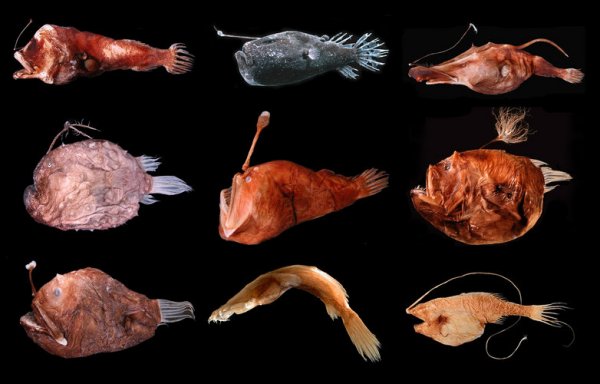
Bioluminescence is very common among fishes, crustaceans, cephalopods (Arthopodes) Cnidarians (Coelenterates), some starfishes and a few animals. Some animals establish a symbiotic relationship with light-producing bacteria.
Importance :
Bioluminescence helps animals in various ways find mates, attract prey, self-defence, search for food etc.
Colouration :
The majority of marine fishes display a wide variety of colours and colour patterns. However, many deep-sea fishes (e.g. viperfish) don’t have any pigment to colour their body, and appears transparent.
Chapter 10 Biodiversity Environmental Crisis And Conservation Of Endangered Animals Food And Feeding
The autotrophic (self-feeding) organisms of the sea / or plants of the sea
Phytoplankton-
chlorophyll-containing microscopic organisms live in the euphotic zone (where sunlight reached). They can produce food with the help of sunlight. Phytoplanktons are the main producer of aquatic ecosystems planktons have a role to maintain carbon balance in the environment.
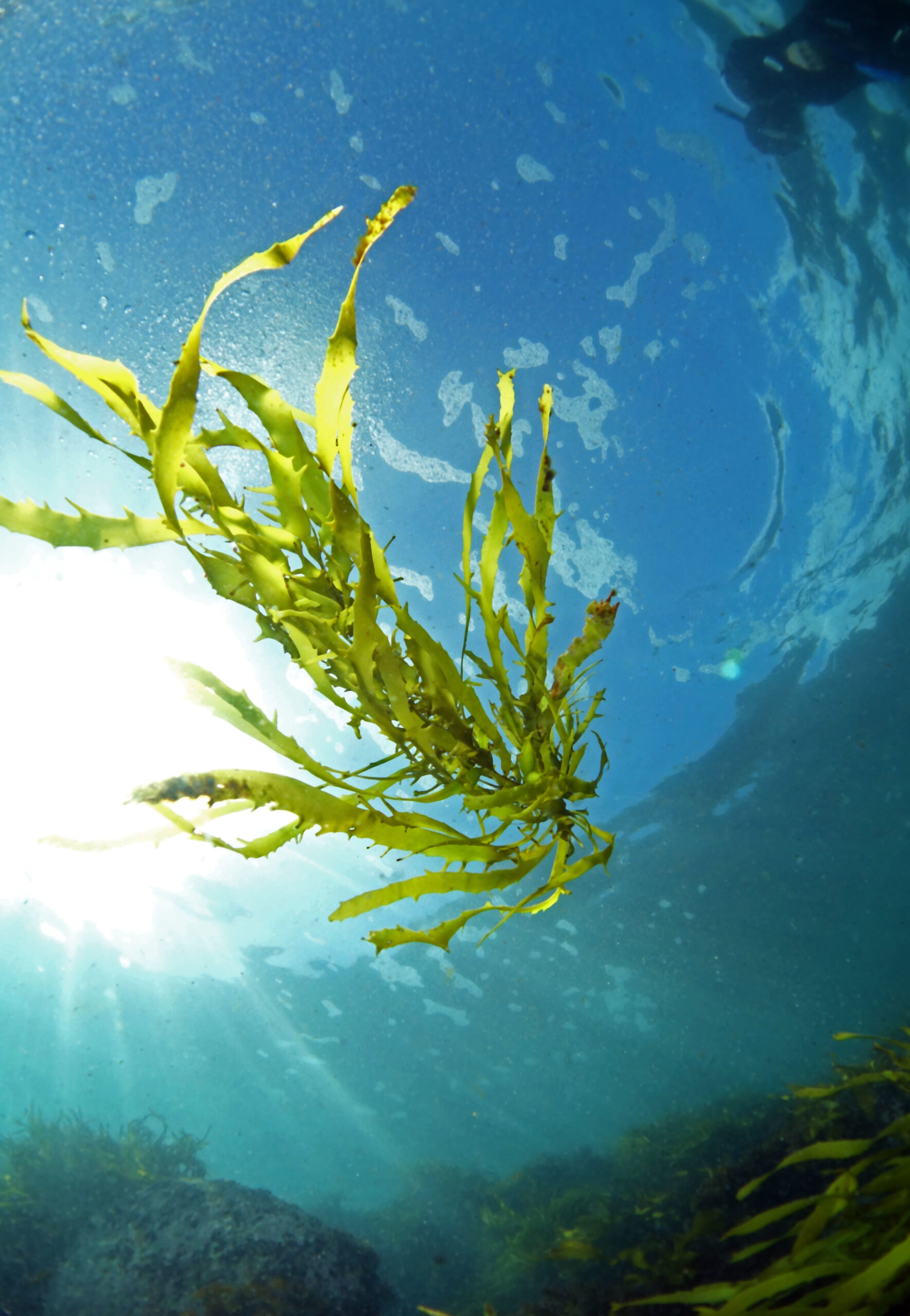
Diatoms—
Diatoms are unicellular algae (phytoplankton) although can form colonies with distinctive transparent cell walls made of silica. They are found in almost all aquatic environments.
Dinoflagellates—
Dinoflagellates are unicellular phytoplankton mostly marine but also found in fresh water. They move with the help of flagella. Some dinoflagellates also exhibit bioluminescence.
Kelp—
Kelp are large brown marine algae seaweeds. Kelp grows in shallow oceans are grows in such a way that they create a forest under the ocean. The body (thallus) consists of flat or leaf-like structure and remains attached with something underwater with the help of a root-like structure (hold fast). They grow very fast.
Chapter 10 Biodiversity Environmental Crisis And Conservation Of Endangered Animals Animals
1. Zooplankton-
Zooplanktons are very small some are microscopic flea-swimming organisms that drift with water currents. The zooplankton community is an important element of the aquatic food chai the most abundant group of animals in the world’s ocean.
The Baleen hales r zooplankton, especially one species in particular called Krill, for example, larval forms of different arthropods, shrimp, kri etc.
2. Sea anemone-
You may notice while visiting the sea-shore (lower intertidal zone) some flower-like animals. If you touch them they will sink deep into the sand. Sea anemones are tube-like invertebrate sea animals with extended flower-like tentacles spread from the upper side (around the mouth) of the body.
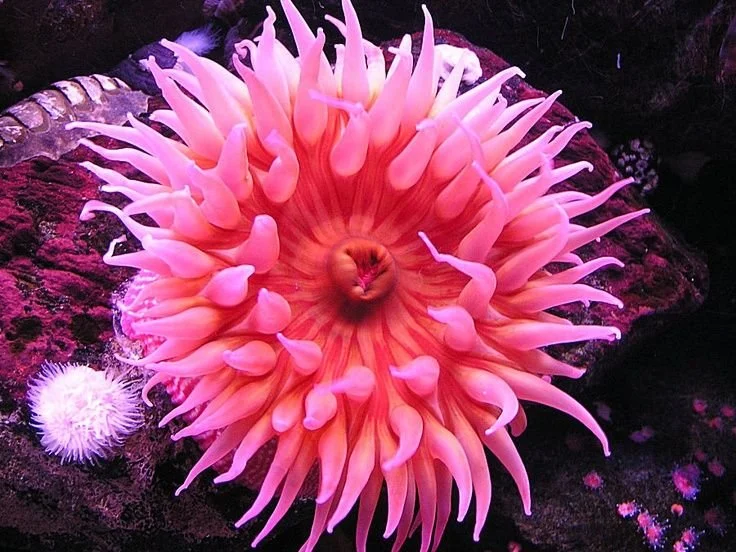
Tentacles are like petals of flower arranged around the mouth opening by one or more whorls. They are sessile attached at the base to the surface beneath it by an adhesive foot (pedal disc). Tentacles of sea anemones contain numerous stringing cells (cnidocytes). They help in self-defence as well as used to capture prey.
3. Sea pen—(Pennatula) –
The sea pen is a colonial invertebrate marine animal of the phylum Cnidaria. They occur in shallow and deep waters from polar seas to the tropics. This graceful creature of the seafloor resembles a pulp, old-fashioned quill pen in colour range from dark orange to yellow to white.
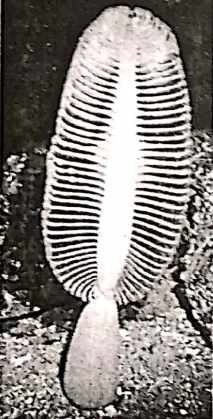
The lower part of the central stalk of the animal (peduncle) anchors the colony in mud or sand and the upper part the rachis bears polyps or branches bearing several polyps (hollow stalks with Sea pen a mouth and tentacles at the free end) Most of the sea pens luminescent or glow when they are touched or otherwise stimulated.
4. Octopus—
Octopus is a rounded soft-bodied marine animal with eight long arms. The soft body can rapidly alter its shape, enabling the octopus to squeeze through small gaps.
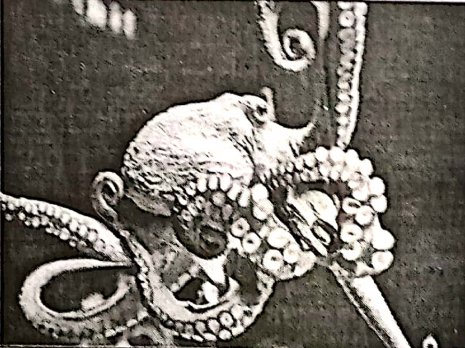
Each arm contains many suckers, a mouth at the centre of the arms. Octopus has two big (bulging) eyes. The eyes and brain of octopus are the most developed organ among invertebrates.
Jet Propulsion –
Octopus expelling a jet of water rapidly through siphon into the sea helps them to rapid locomotion. All Octopuses are venomous (poisonous) but only the blue-ringed Octopus are known to be deadly to humans. Octopuses expel a special ink from ink-sac to protect them from predators.
“WBBSE General Science Class 8 Biodiversity, Environmental Crisis Chapter 10 key concepts”
The giant pacific octopus is the largest known octopus species. Octopuses have a relatively short life span some species live for as little as six months. The. giant specific octopus may live as many as five years. Octopus life span is limited by reproduction: males can live only a few months after mating and female die shortly after their egg hatch.
Female octopus guards its fertilized egg in such a way that they do not take any food and die from starvation after the eggs hatch, (due to the inactivation of digestive glands.)
5. Squid and cuttlefish (example Loligo)—
Squids are marine molluscs closely related to octopus and cuttlefish. The body is elongated (torpedo-shaped) there is a fin near the end of its body. Squids are probably the Squid is a good swimmer and the fastest marine invertebrate. Squids is a good swimmers and certain species can fly for short distances out of the water.
The skin contains a pigment (chromatophore) which enables the squid to change- colour to suit its surroundings. The Head-end bears eight short arms and two long arms called tentacles each arm has many suckers along the edge.
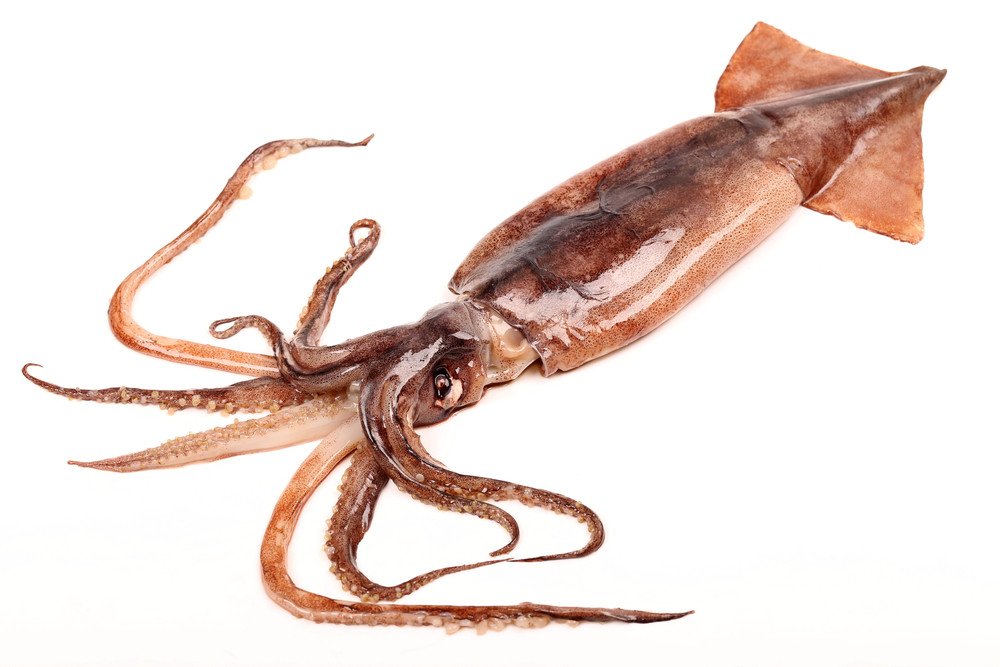
When attacked to escape from predators spraying brownish or blackish fluid makes the water turbid to make fool its enemies. The Giant squid lives in the deeper parts of the Atlantic ocean. (50 – 60 feet long).
Cuttlefish (example Sepia)—
Cuttlefish is a close relative of the squids. These marine molluscans have broad bodies with long undulating fin on each side. This animal lives in shallow water on a sandy bottom. They have a sleeper-like calcium-containing internal shell (cuttlebone). You may seen these plenties in the seashore. (This article is sold as sea foam)
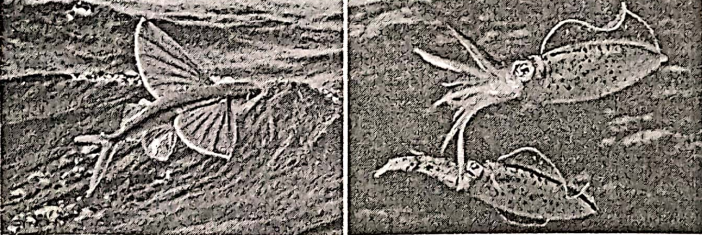
6. Shark—
Sharks are marine fish but they have soft more elastic cartilaginous skeletons not hard skeletons like bony fishes. They have usually five-gill slits on either side of head (sometimes seven).
If you put your hands over shakes body you will feel roughness. This is because the skin of a shark is entirely covered by hard microscopic placoid scales (dermal denticles)
- Dwarf Lanternshark a deep sea species about 17 centimetres (6-7 inches)
- The whale shark (Rhinocodon type) is the largest shark (it is the largest fish in the world)
- Whale sharks, megamouth sharks and Basking sharks are (filter feeding) plankton feeders
- Whale sharks and lunar-headed sharks are known as man-eaters.

The scales are supported by the spine which feel rough when stroked in a backward direction. Sharks have numerous sets of replaceable teeth. If loss one set then replaces by another. ‘Well-known same species are – great white shark, blue shark, hammer-headed shark are predators.
Sharks possess heterocercal caudal fin in which the dorsal portion is usually noticeably larger than the ventral portion. Sharks have keen olfactory senses. Some species are able to detect as little as one part per million of blood in seawater. Sharks have a special sensory organ known as the ampulla of Lorenzini which help them to sense electrical fields in the water.
Some sharks lay their eggs in the water, and most of them are kept in egg case which protects the developing embryo (s). Some sharks (Hammer-heads) give birth to fully functional young like mammals. Sharks are found in all seas. They are usually common down to the depth of 2000 metres (7000 ft) and same live even deeper.
Among 470 species only four have been reported attacks humans these are the great white shark, oceanic white lip shark, tiger and blue shark.
- The largest fish is the whole shark which grows to more than 15 metres (15 -18 m)
- The biggest marine animal is the blue whale with a recorded length of 31 metres.
- Giant kelps grow 60 metres tall, one of the tallest seaweeds.-
- Starfish and may other echinoderms are radial symmetry which means their body parts are arranged around a central axis.
- Starfish are not true fish. They do not have gills, scales or fins and no vertebral calcium like fish.
Chapter 10 Biodiversity Environmental Crisis And Conservation Of Endangered Animals StarFish
Starfish is a five-armed star-shaped marine echinoderm. Starfishes are not fish they are invertebrates. They are flattened have a central disc from where five arms radiate. The upper surface (aboral side) is granular or spiny. Mouth present in the ventral surface (oral side).
Starfish have tube feet which help In locomotion (moving) and feeding. Tube feet are hollow with sucker work like a vacuum cleaner. Many species are brightly coloured in various shades of red or orange, while others are blue, grey or brown.
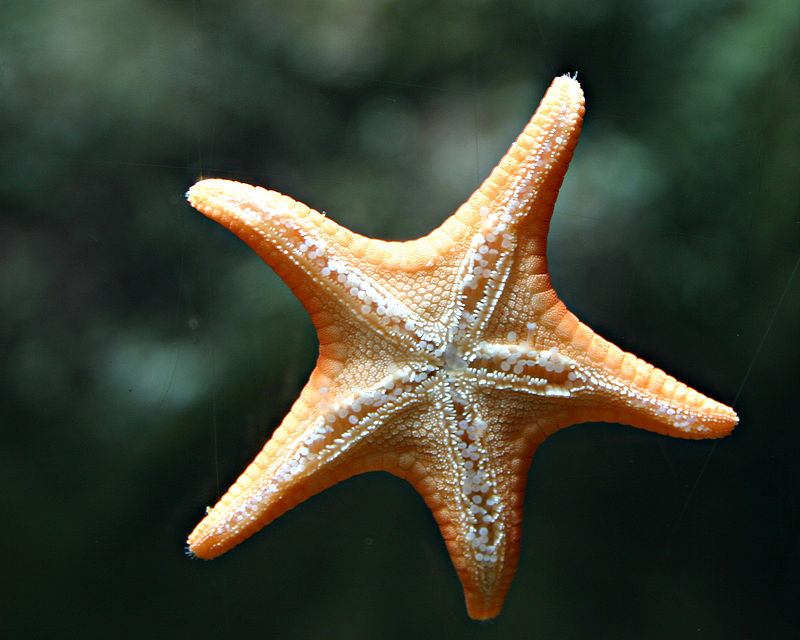
Starfish have a specialised water vascular system made up of a network of fluid-filled canals. This system helps in locomotion, adhesion, food manipulation and gas exchange. Starfish are found in the intertidal zone as well as in the deep sea.
Chapter 10 Biodiversity Environmental Crisis And Conservation Of Endangered Animals Sea Animals
Pollution in the ocean and problem of Marine life :
Oceans are the largest water bodies on the planet. It is the home of a wide variety of marine animals and plants. Over the last few decades, human activities have severely affected the marine life on the earth oceans.
Ocean pollution or marine pollution is the spreading of harmful substances such as oil, plastic industrial and agricultural waste, pesticides, and chemical industrial particles into the ocean.
Any type of ocean water (sea water) contamination which affects living organisms is called marine or ocean pollution. Mining for materials such as copper and gold is a major source of contamination in the ocean.
Chapter 10 Biodiversity Environmental Crisis And Conservation Of Endangered Animals Ocean Pollution
1. Pollution by sewage, chemical sewage or polluting substances flow through sewage, rivers or drainages directly into the ocean. Chemical fertilizers and pesticides use near by fields are also washed out and mixed with seawater. Excessive nutrients such as nitrates, and phosphates, commonly originate in domestic sewage, runoff from agricultural fertilizers, waste material from animal feedlots, packing plants etc.
They stimulate the growth of microorganisms. The number of phytoplanktons increases enormously consequently they cover the ocean surface. This is called an algal bloom. An increase of dinoflagellates also causes algal bloom.
It turns the seawater red. Toxins secreted from these algal booms also cause the death of many marine animals. Besides this decrease in the transparency of water hampered the penetration of sunlight into the seawater. It also hampered the photosynthesis of sea plants.

The presence of too many planktons and other microorganisms reduces dissolve oxygen (increases biological oxygen demand = BOD ) respiratory activities of marine animals and plants and lead to the death of marine animals.
Oil spills—
An oil spill is an accidental and incidental discharge of petroleum in the ocean. The main source are offshore exploration wells, extraction wells, oil refineries, and the loading and unloading of tankers.
2. Oil spills—
During oil extraction from sea and oil transportation, linkage of tanker ships and during the war, crude oil mix with sea water which causes ocean pollution. Oil form a layer in the upper surface of sea water which prevents oxygen to get dissolved in water. As a result, marine life forms can die due to oxygen deficiency.
Besides this oil form a layer over the body of large sea animals especially birds and mammals. This severely damages the thermostatic balance (body temperature balance) eyes and noses smearing (coating of greasy substances) of sea birds which because incapable of flying and feeding resulting in their death.
Oil when entering inside the body it also damages internal organs. During the Iraq war a large number of sea animals (especially birds and mammals) died due to ocean pollution.
3. Plastics—
Plastic objects float on the sea coming from rivers, canals or from the sea shores or sometimes in harbours and ships. When this object is consumed by sea animals in confusion this large object creates an obstruction which hampers the normal functioning of the alimentary system. The animal can die due to starvation or infection.
4. Increase in acidity of ocean water—
C02 emission in the atmosphere increases due to various human activities. The sea absorbs a large part of this carbon dioxide (C02). This dissolved C02 and increase the acidity of seawater. This affects sea life. Gill-breathe animals face difficulties to absorb oxygen from acidic seawater for their respiration.
Besides this, the animals which have chitinous or calcareous covering shells such as crabs, lobsters, snails, and corals face difficulties in forming their shells and acidic water can destroy the calcareous shell.
5. Thermal pollution—
Various industrial processes may utilize water for cooling and the resultant warmed water has often been discharged into sea in some coastal areas. Coal or oil-fired generators and atomic energy plants generate a large amount of waste heat which is carried away as hot water and caused thermal pollution. Thermal pollution can exert a disruptive effect on coastal marine ecosystems.
Chapter 10 Biodiversity Environmental Crisis And Conservation Of Endangered Animals Life In Desert
A Desert is a very dry area of land often covered with sand or rocks. Where there is very little rainfall (20 cm – 25 cm) and few plants and animals can live. Desert covers approximately one-third of the earth’s surface. The two largest deserts on Earth are in the polar areas Antarctica (5-5 million sq. miles).
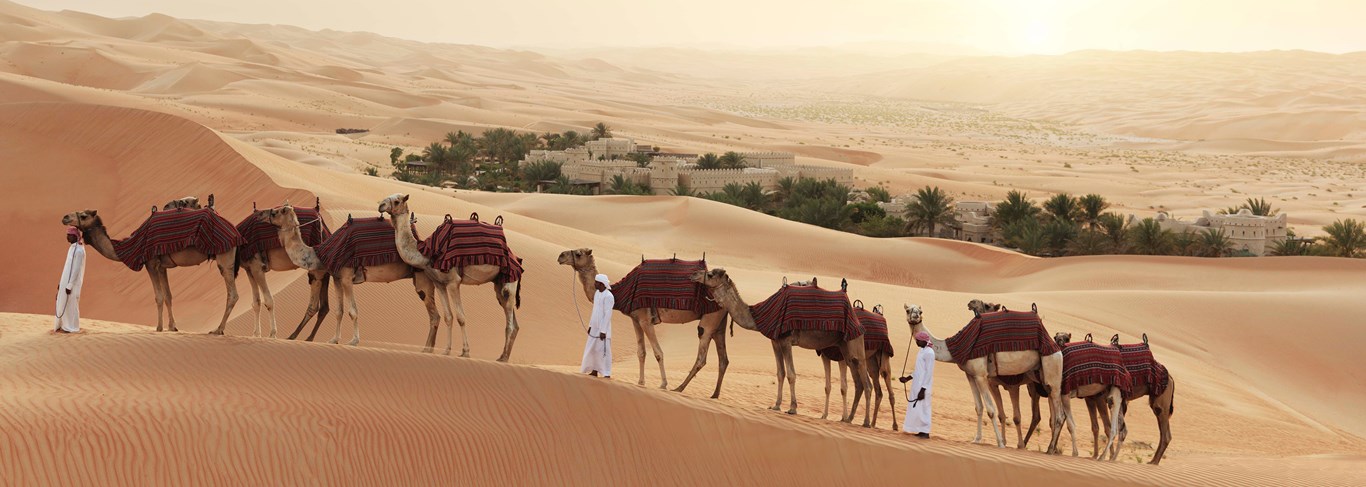
The second largest desert is the Arctic polar desert. (5-4 million Sandy desert sq. miles). It extends over parts of Alaska, Canada, Greenland, Iceland, Norway, Sweeden, Finland and Russia.
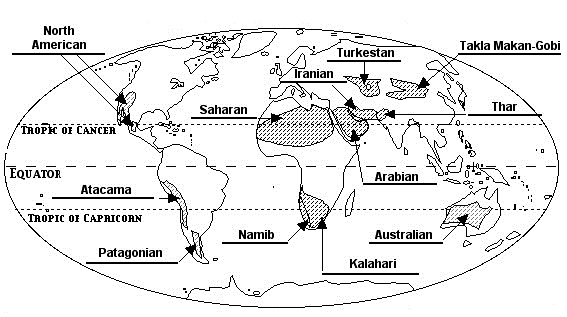
Non-Polar desert-
The rest Of Earth’s deserts are outside of the polar areas. The largest is the Sahara Desert a subtropical desert in northern Africa (which covers 3-5 million sq. miles) Across the world around 20% of the desert is sandy.
Antarctic deserts and Arctic deserts are cold deserts where these are land covered by ice and another sand cold desert is the Gobi Desert of Asia. Other important deserts are Sahara (Africa) Arabian desert (Middle east), and Kalahari (Africa). In India, the Thar desert covers a major part of Rajasthan.
The days in the desert are extremely hot and the nights are cold. Deserts are characterised by scanty flora and fauna. Only the organisms having specialised structural, physiological and behavioural adaptations to withstand the extremes of temperature and aridity can survive there.
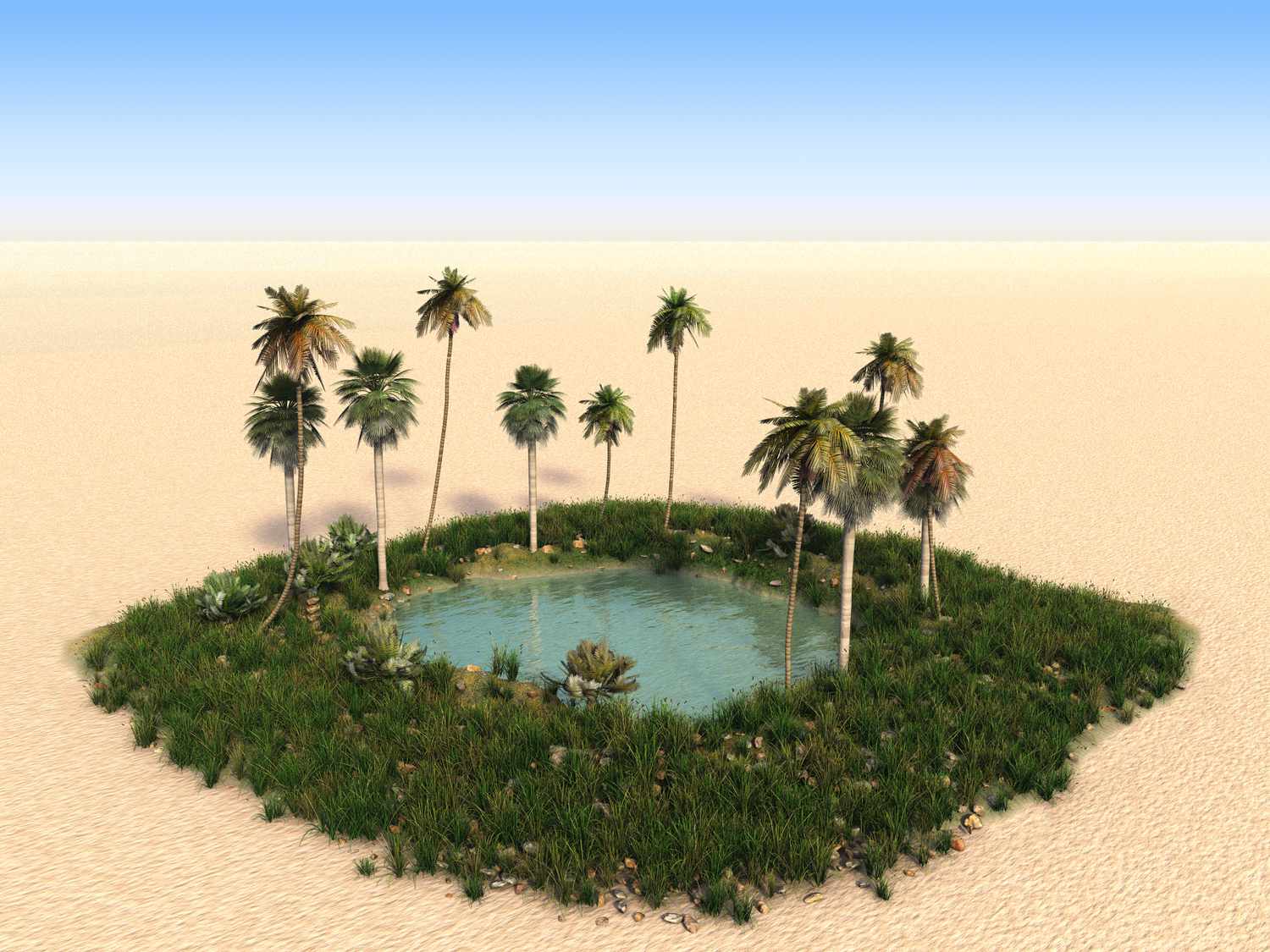
The Equator passes through the middle of the earth. Deserts do not occur near the equator. Higher in the atmosphere the new cold, dry air rises and moves away from the equator.
- Cold deserts are found in the Antarctic, Greenland, Northern and Western China, Turestan, and Iran. The Gobi desert is a cold desert.
- Hot deserts of the world are located between 15° – 30° north or south of the equator.
Nearly one-third of (1/3) earth’s land surface is desert.
There are four different types of deserts based on their geographic situation.
- Polar desert
- Subtropical desert
- Cold winter desert
- Cool coastal desert
Oasis :
Oasis is an isolated area in the desert with some vegetation, animals and small water sources like a pond or lake. A little bit of rainfall in the desert accumulates in the layer of the rocks found deep. From the deep water comes out when the layers of rock break form’a a pool or small lake.
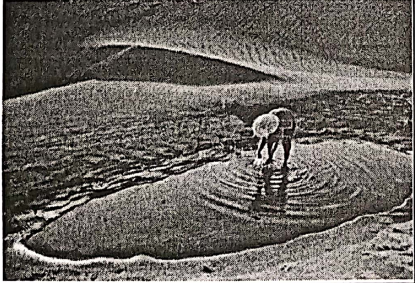
This is mainly due to the artesian aquifer, water can reach the surface naturally by pressure or by man¬made wells. Surrounding this pond or small lake trees grow. As the trees and a few other plants grow different animals also appear. The number of oases is very limited.
Chapter 10 Biodiversity Environmental Crisis And Conservation Of Endangered Animals Plants In Desert
A Desert is an endless stretch of sand with high temperatures and high concentrations of C02. Soil is absent. There is a profound scarcity of water. Yet plants grow in such advanced conditions. Desert succulents such as cacti or rock plants survive dry spells by accumulating moisture in their fleshy tissues.
They have an extensive system of shallow roots to capture soil water rapidly (within a few hours) after it has rained. Roots of many plants grow deep into the soil to collect water, to avoid friction with sand root caps become strong.
In addition to these many cacti and other stem-succulent plants of hot deserts grow vertically and usually leafless green trunks (stem) that use sunlight of the early and late hours of the day. Many plants have no leaves and leaves turn into thorns to check evaporation.
The number of stomata in leaves are less. Plant body covered by cuticle to prevent evaporation. Some plants come out after little rain and survive very few days but within this short life span, they produce flowers and seeds. In some cases, seeds lie dormant stage and wait for a favourable environment or conditions.
There are other long plants that can survive for long period without water.
Cactus-
Ordinary cactus or prickly pear is found in most of the deserts of the world. No animal or bird can .eat them as they are covered by thorns. Thorns are their protective organ as well as prevent evaporation of water. Their stems are green and able to make their own food by the process of photosynthesis.
Saguaro Cactus-
A type of tall tree like giant cactus having branches can grow up to 50 feet (12.2 metres). Its life span is about 150 to 200 years (usually found in the Arizona desert, Mexico) A saguaro cactus is able to absorb and store a considerable amount of rainwater (six to eight tons of) water is their body.
They use this stored water as needed. So they are able to survive during periods of drought. The body of this cactus is covered by long thorns. Flowers are whitish to yellow in colour and open well after sunset. Fruits are edible ruby red and contain many seeds (about 2000).
“WBBSE Class 8 General Science Chapter 10, Biodiversity Environmental Crisis summary”
The desert travellers quench their thirst with this plant. They collect water by cutting their expanded trunk. The fruit are used to make Jam. Woods are used to making strong ropes and building houses.

Joshua Plant –
A type of succulent plant that they store water. They grow about fifteen to forty feet long. They are considered trees of the desert. Their life span is about 200 years. This plant usually have a single trunk and grows three to nine feet tall before branching.
Joshua trees are fast growers of the desert. Branches end with dusters of spiky leaves and white rounded flowers. A number of mammals rely on Joshua trees for food. Jashua plants have very thin leaves therefore less water is evaporated.
They have a special and extensive root system. They have special root systems so they can soak up a lot of water. Man use the leave of these trees as plates and bowls.
Mesquite plant-
These are leguminous desert plants with long roots. They grow up to 8 metres. They have one or multiple trunks with bipinnate leaflets. They can store water but they have long tap root which can reach below upto the rock layer. They collect water from that rock layer. They protect the sand dunes of the desert.
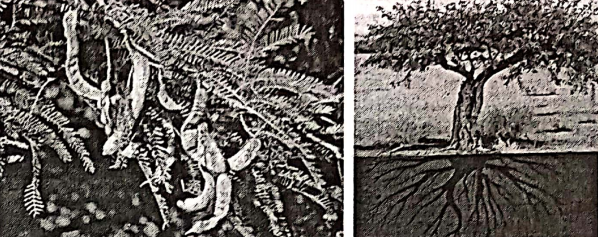
Cactus as food-
Cactus is a very important as well as useful plant for the desert people. Food is stored in the roots of the cactus. For this roots become very large and thick. Desert people are able to recognise this root part. The fruits of the saguaro cactus look like a watermelon.
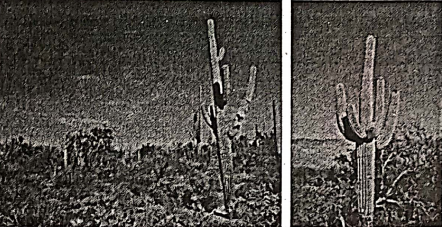
Write down the adaptations of desert plants in tabular form and the purpose of that change :
| Desert plants | Adaptation | Purpose |
| 1 | ||
| 2 | ||
| 3 |
Chapter 10 Biodiversity Environmental Crisis And Conservation Of Endangered Animals Wild Life Of Desert
The environmental conditions of the desert are not so favourable like other environments. Desert animals get radiated heat of the sun. The heat also enters their body from the soil and rock through the conduction process and from air through the convection process. In addition to high temperatures, they face scarcity of water.
But the desert animals adopted themselves with the condition. Some animals like camel have suited them well with the surrounding condition. In the sandy desert, there is terrible heat during the daytime and there is cold in night two extreme conditions. Usually, desert animals remain to stay in their den (dig burrows in the sand) and come out in the evening.
They are nocturnal in habit. Some animals are active for a few hours only during the early morning. Most of desert animals are small in size. A desert, lizard (Moloch) can absorb water through its moisture-absorbing (hygroscopic) skin.
- Many desert animals develop a protective covering on their body to prevent water loss by evaporation. Skin of some desert
- Animals become thick to prevent loss of water.
- Some desert animals produce water by their own metabolism (respiration).
- Some desert animals during summer migrate to high and cold places and return during the winter season.
- Some desert animals when the temperature increase go to deep sleep, this is called aestivation. During this time their respiration rate and heartbeat decrease.
Camel-
The camel is an excellent example of adaptation to desert life. Camel is known as the ship of the desert. Two types of a camel on the basis of the hump. One-humped (Arabian camel) and two-humped (Bactrian camel).
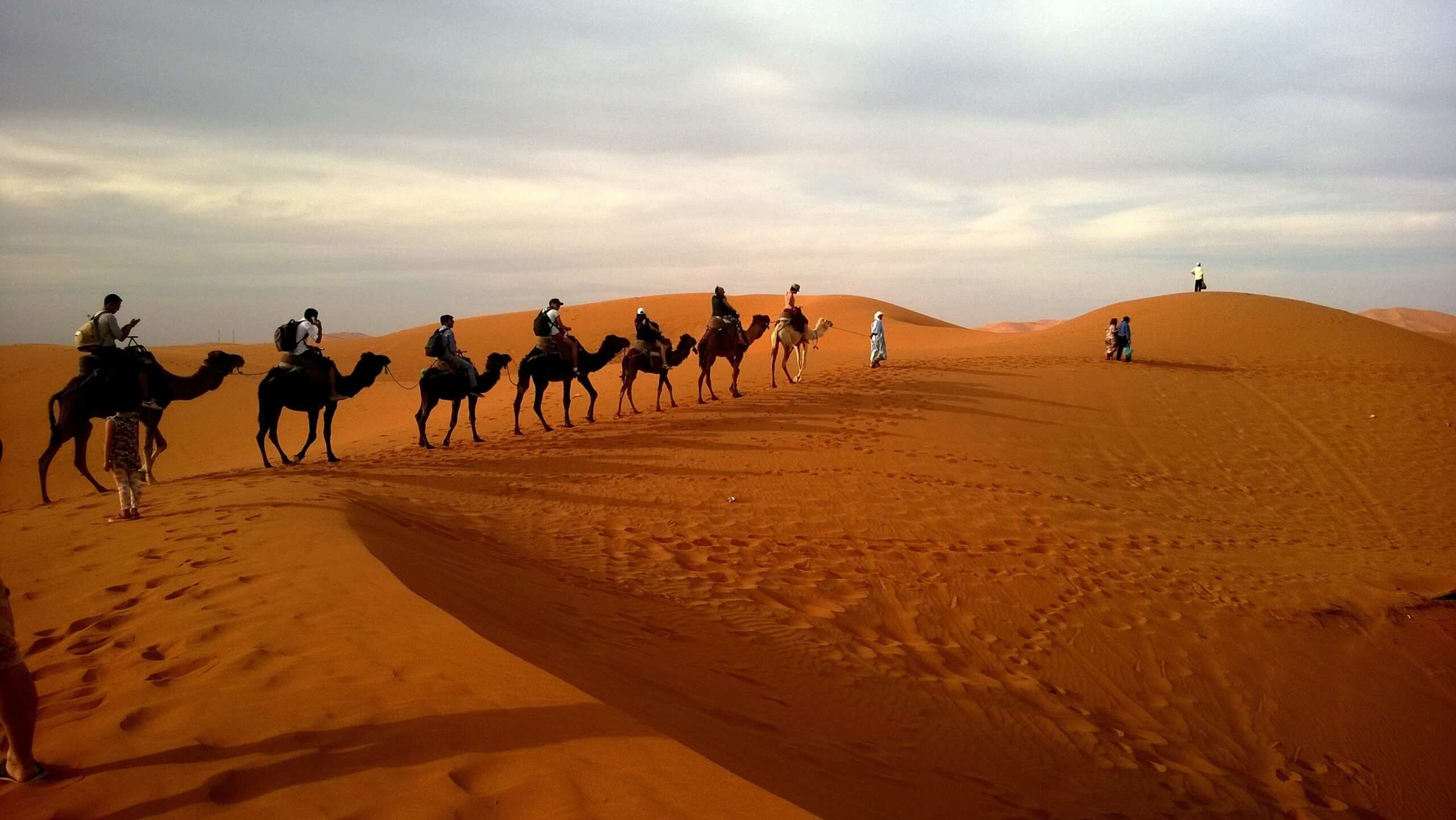
Important Adaptation of camel :
- The hump on the back of the camel is not a water-containing bag. It is actually a reservoir of fat. This fat (reserve food) is utilized when it does not get anything to eat. They collect their energy from this fat. For that the hump gets reduced when the camel does not have anything to eat.
- Camel can live without food and water for seven days or more (may up to 10 – 12 days). When water is available it can drink as much as 50 litres (25 gallons) at a time. This water gets evenly distributed in all the tissue of the body.
- Legs are long and wide enough to cope with the sandy desert condition.
- A pad of thick tissue is present near the knees and below the sternum that helps the camel to sit on the sand. Its hooves are covered by a large sole which helps it to move on hot slippery sand.
- Very little water is excreted from its body and urine is highly concentrated.
- Sometimes sand-storm occurs in the sandy desert. Camel can close and open which is covered by muscle. They have transparent eyelids and they have a short, thick brush-like
- eyelashes. Snout is slender which leaves a cleft in the upper lip and the tongue of the camel is made up of strong muscles which help them to collect food from thorny bushes.
- Legs long and wide enough.
- Its breathing rate is very slow to prevent water loss during breathing.
- It can adjust its internal temperature and keep it higher than that of its surroundings this mechanism helps the camel to prevent water loss.
Observation :
Different body parts of camel and their structural peculiarities :
| Body parts | Structural peculiarities |
| 1. Legs | |
| 2. Snout | |
| 3. Eyes | |
| 4. Lips | |
| 5. hump |
Chapter 10 Biodiversity Environmental Crisis And Conservation Of Endangered Animals Lizards Of Desert
There are different types of lizards in desert. Most of them come out during the evening or night in search of their food. They store fat in the tissues of their wide tail. Many desert lizards have the ability to adjust colour- due to temperature (this is known as metachromatism)
They cannot regulate their temperature internally so they rely on their environment to keep the temperature in the correct range. When the temperature cools, lizards turn darker. Dark colours increase heat absorption when desert temperatures rise their colour became lighter, which reflects the heat and keeps the lizards cooler.
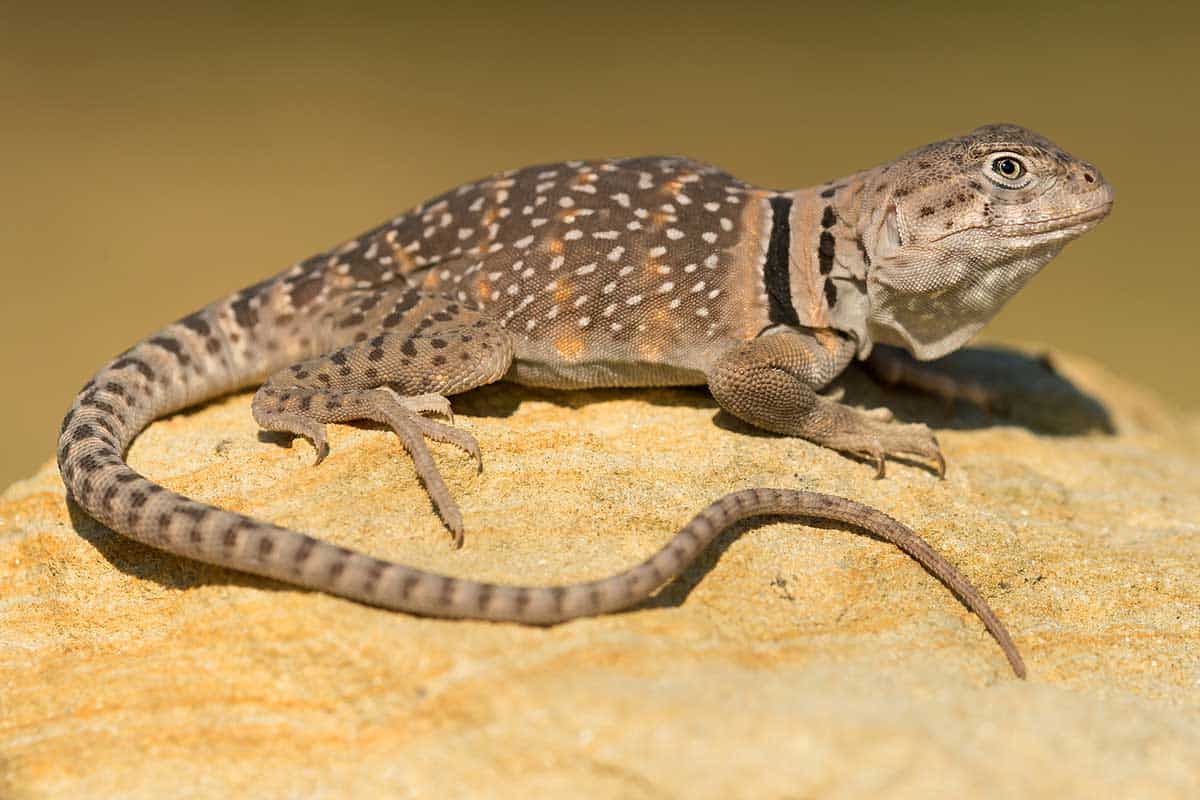
Their eyelids are covered with transparent membranes. They are usually insect feeders.
Rattlesnake-
Rattlesnake is one of the most poisonous snakes of the desert. They have a hollow rattle at the end of the tails. This rattle makes a loud rattling noise when vibrating. Their body colours very much similar that of their surrounding’s sand colour. They have two hollow fangs, Rattle snakes consume mice, rats, small birds and other small animals.
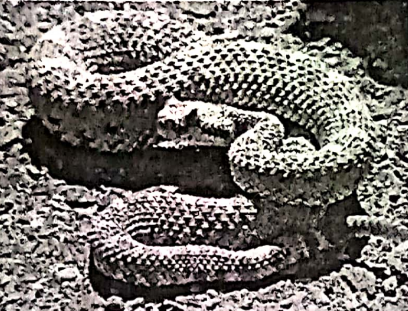
The prey is killed quickly with venomous bits. Eyes and a set of heat-sensing pits on their face enable rattlesnakes to locate prey and move towards. Rattlesnakes are cold-blooded animals and can swim well over sandy surfaces. Rattle shakes have an exceptionally keen sense of smell.
They can sense olfactory stimuli both through their nostrils and by flicking their tongue. Rattle snake’s skin has a set of overlapping scales which cover the entire body providing protection. They are nocturnal. Their main predators are eagles, hawks, owls, king snakes etc.
Gerbil or sand rat—
Gerbil is a small mouse-like rodent specially adapted to living in dry desert conditions. This nocturnal animal lives inside the burrow by digging in the sand. They can jump like kangaroos therefore Gerbil is known as a kangaroo rat. They have a long tails.
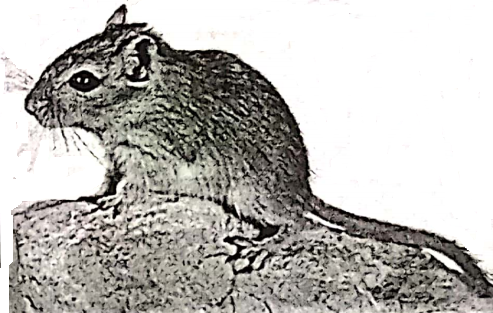
Their body colour is white to brown they can change their body colour with the sand. This device is for protecting themselves from enemies. They are nocturnal and eat seeds and small grass, small crops, fruits, and small insects and can live with their whole life without taking water. Their ears are very active.
Animals of Thor—
The Thor, the great Indian desert has an unmatched variety of fauna. Indian wild Ass is one the endangered species of Rann of Kutch. Some other native species of the Thar desert include the desert scorpion, the red fox, the blackbuck, the Indian Bustard, the wild cat etc.
The Indian spotted eagle is one of the biggest flying predators and threatened species found in Thar. The Great Indian Bustard is among the heaviest flying birds in India found in the Thar desert. The Indian national bird peacock is also found here.
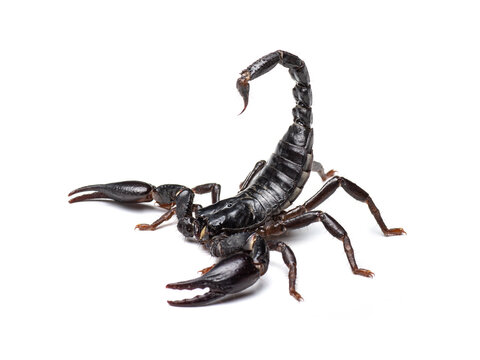
The Blackbuck (Antilope cericapra) is one of the most famous antelope natives to this desert. They are dark brown in colour and have a white circle around the eyes. blackbuck male antipode has beautiful twisted-ringed horns. Kites, doves, sand hens and some other birds are also found there.
Make list of desert animals and their characteristics and adaptations.
| Name of the Desert animals | Specialization for Desert condition |
| 1. | |
| 2. | |
| 3. |
Chapter 10 Biodiversity Environmental Crisis And Conservation Of Endangered Animals People Of Desert
Though more or less extreme climatic conditions prevail in deserts. Vet people live in different deserts since prehistoric times. Every group of people has some speciality. The Thar desert is the most densely populated desert in the world. The notable desert dweller groups are Wardha, Bhil, Gadi-Lohar etc.
The main occupation of the people of their desert is animal husbandry. A colourful culture rich in tradition prevails in these desert dwellers. The Bedouins a historically popular group of people inhabited the Sahara and Arabian desert. They wear a long loose dress which covers their whole body that protects them from sun and heat.

They are traditionally divided into tribes and share a common culture of herding camels and goats. Bedouins are nomads (have no fixed location) who move from one place to another. They travel mile after mile on a camel at stretch for several days, take a rest in tent for a few days and start again travelling.
The Himba people live primarily in the northwest region of Namibia. The Himba people cover their bodies with red ochre and animal fat to protect their skin from the powerful sun. The Himba men and women are recognised around the world for their colourful ornate jewellery and dress.
In the desert of Namib (present in Namibia) live a special ancient group of people is Cushman. They dig holes in the sand and live there. They are a good hunter group. They use bow and arrow. After hunting they eat that animal by roasting it. The people live in the Kalahari desert is known as San Bushman.

They dig and make a hole in wet sand and suck water from land by a long strong hollow grass stem. These people use empty Ostrich egg shells as waterpots. They have a special ability. They can easily understand whether water is present in that sand or not by seeing the design of the sand.
“WBBSE Class 8 Science Chapter 10 Biodiversity and Conservation, definitions and examples”
Tuareg, the large tribal people live in the Sahara desert (from Libya to Southern Algeria). They make hut with a special type of grass found in the desert. The Red Indians of American deserts live together. They build their house together. Every house as a good number of rooms. These stone-made houses are called Pueblo.
Animal world in the Polar region:
Polar regions are the geographical areas place surrounding the north and south poles of the earth. The Polar regions are the coldest place on the earth, hardly seeing the sun during the winter and having 24 hours a day in the summer.
Two polar region-Arctic is the area surrounding the North pole and Antarctica is encircling the south pole. The arctic region includes almost the entire Arctic Ocean and the northern parts of America (Alaska) Canada and Europe (Denmark, Norway, Finland, Sweden, Iceland, Russia) and parts of Asia.
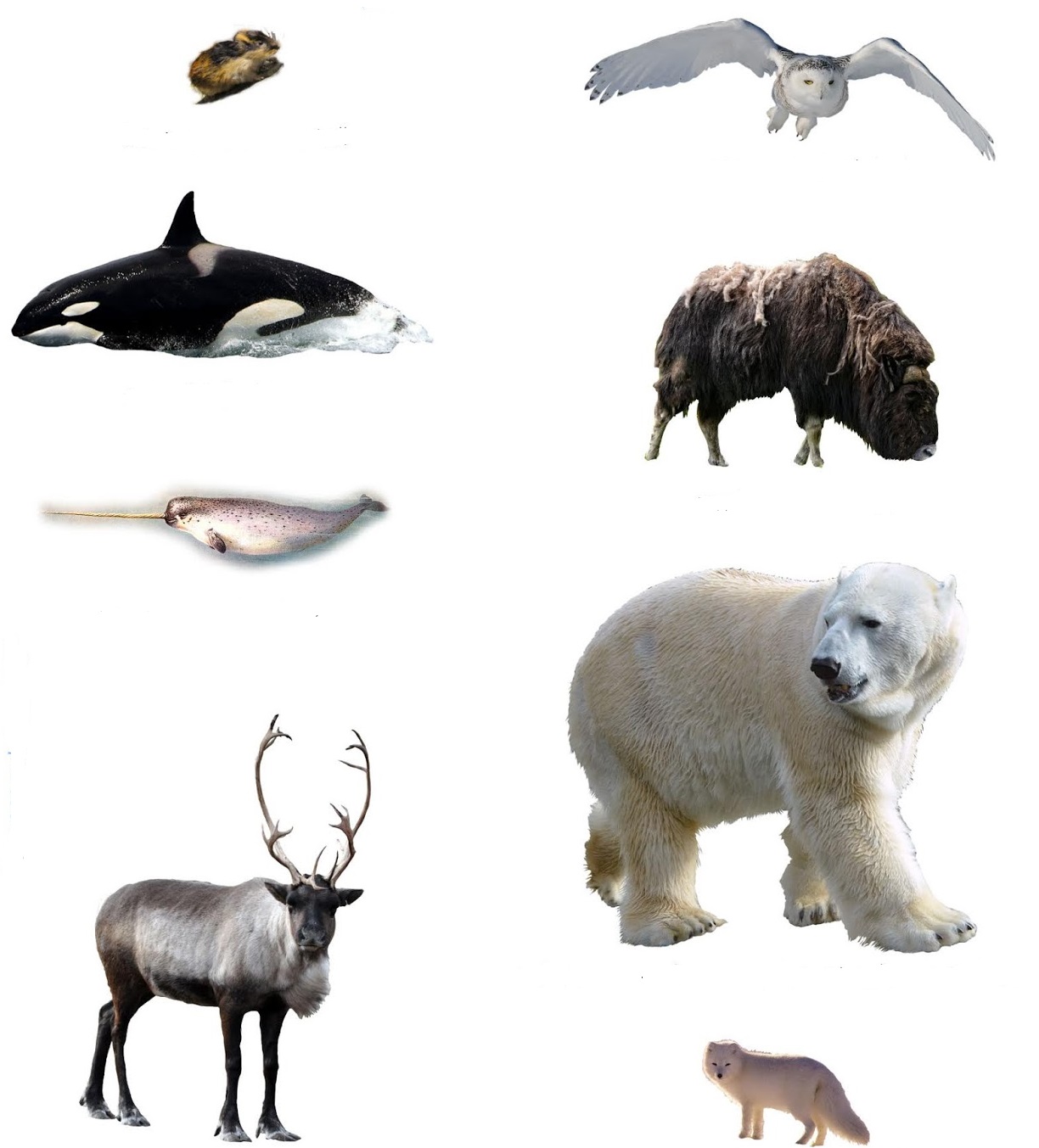
Antarctica includes the continent of Antarctica and the parts of the surrounding Southern Ocean.
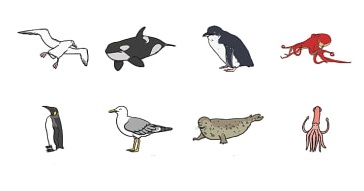
The temperature in the polar region varies for- 88°C to 15°C. Living in polar regions are very difficult. Though a rich diversity of wildlife— both on land and under the sea surface. Millions of people also live in the Arctic but Antarctica has no permanent inhabitants.
In the Arctic region, a good number of mammals are found. They are mainly Seal, Sea lions, Whole, Caribou, dogs, dolphins, etc. Wolves are the top predators of the Arctic tundra and polar bears dominate the frozen waters, deeper in the sea Seals, Sea lions, walruses, and killer whales are common in this region and usually feed on the fish.
The animals are usually found are the Arctic fox, Walrus, Seal, snow owl, and white hair. Penguins are the most abundant and best-known animal of Antarctica. Besides this whales, seals, and sea birds (Albatron). Antarctic krill (small crustaceous) are important animals in Antarctic food chains.
How the animals able to adjust themselves within the polar condition?
Chapter 10 Biodiversity Environmental Crisis And Conservation Of Endangered Animals Migration
Migration is the mass movement of animals from one geographical region to another. Many animals of the Arctic region like birds, fish, Reindeer etc. migrate from colder regions to warmer places to find food, to lay eggs or give birth to their young ones.
For example-
The Arctic Tern (Sterna paradisiacal) a small seabird that cover a distance of around 40,000 to 90,000 km in each year. The Arctic Term breeds in the Arctic before making its way to the Antarctic (winter is spent here). It is probably the longest migration undertaken by any bird.
How the Animals (mammals) of polar regions stay warm?
The Arctic is very cold. Warm-blooded animals are usually found there. Now the question how do the Arctic animals stay warm in ice water and cold land area? Due to global warming ice packs of poles melt rapidly and if the condition prevails. The polar bear will not survive.
Animals like Walruses, Seals and Polar bears all have a thick layer of fat (in the case of a Polar bear 4 inches wide) called blubber that keeps them warm in the ice-cold water of the Arctic and Antarctic. Polar bears have black skin underneath two layers of fur that help trap the heat when they are on land.
They have small ears and large paws. The fore paws of the polar bear are partially webbed which assists them in swimming. Their eyes are well adapted to see things underwater. Their sense of smell is highly sensitive and helps them to detect food sources (32 km away). This helps them to predate upon their prey.
Penguins are distinctive flightless birds of Antarctica. Their wings have evolved into flippers which they use to swim through the thick water in pursuit of krill fish and others.
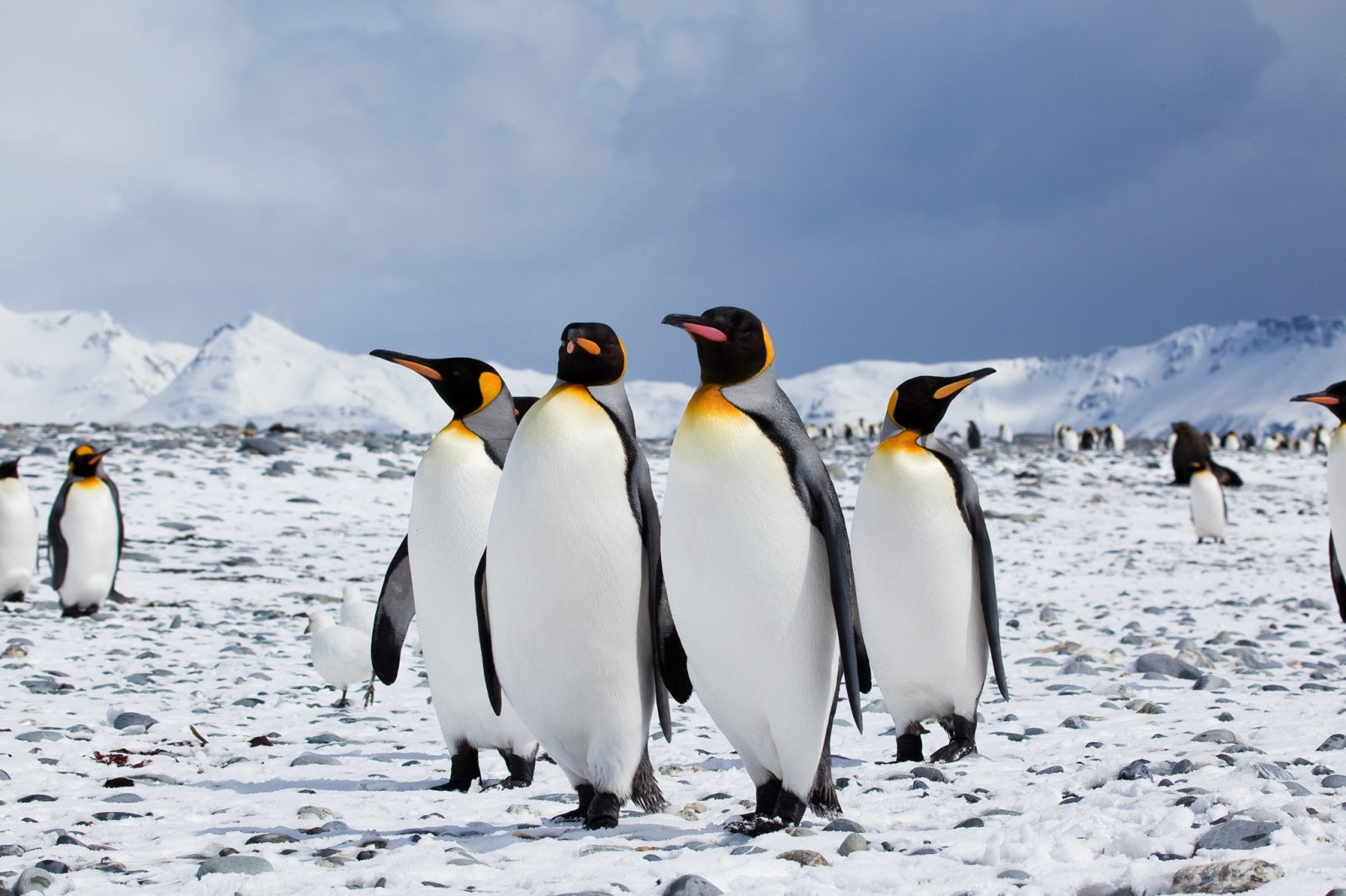
Inhabiting the ice and sea of the Arctic Polar Dears arc well equipped for survival in harsh environments, TVvo coats of fur and a thick layer of blubber help them to insulate their body from the cold. Polar bears’ skin is black which helps them to hold the maximum possible heat and the fur (hair) is not actually white it is actually transparent mostly hollow air-filled and holds no colour.
If only appear white because it reflects visible light. The white fur helps polar bears to camouflage in the ice and snow. This helps them to predate upon their prey. Polar bears have a layer of fat under skin that can be 10 cm (4 inches) thick.
Although their fur is the prim a 17 source of insulation, the fat helps keep heat in as well. The fats of polar bears also help to stay in the water. Polar bears are our planet’s largest land predators and are highly dependent on older stable pack ice in the Arctic region.
The habitat of the polar bear are shrinking day by day due to global warming. Global warming is the main cause of ice melting. People are the primary enemy of polar bears they have been hunted over time for fur, skin and nails.
Hibernation :
Hibernation is a behavioural adaptation that allows animals to survive during the winter months. Many terrestrial animals of the Arctic region go through hibernation at the beginning of winter. Small ears and short tails offer less open (furless) surfaces helping the polar bear to maintain body warmth.
How do arctic animals lay eggs or give birth to their young ones?
Most of the Arctic animals abstain from giving birth to young during the intense cold. Usually, they lay eggs or give birth to young during the short summer when vegetations also grow for short period. A female polar bear normally gives birth to 2 cubs, (it may one to four) during January in the den she built to keep them safe.
Where they can grow big and strong until spring. The cubs feed on their mother’s milk during this time. Dens are normally dug by the mother’s front and hind paws in snow drifts.
After about 3 or 4 months polar bear cubs venture outside the den with their mother. There are more than 250 types of fishes are found in the arctic ocean common of them are—Salmon, codfish, Halibut, etc. To survive in the cold, polar fishes have evolved suitable physiological and biochemical mechanisms.
Freshwater habitats exist in the Arctic but are more limited in Antarctica. During winter months the atmospheric temperature is very low it drops below freezing and the upper layers of water in the lakes and ponds freeze in 0°C while the lower part still remains at 4°C (water is heavier at 4°C, density) of water is high of this temperature so the lower water remains liquid and ice floats on top fishes and some other aquatic animals remain in this liquid layer.
There are other dangers that fish face in freezing waters like death. The body fluid of an ordinary fish can solidify if the temperature of the surrounding water drops below – 5°C. So Arctic and Antarctic fish have adjusted to their surroundings in an interesting manner.
Certain species of cod, flatfish and polar fish have reduced metabolic rates and’ produce antifreeze molecules (glycoprotein) to reduce the freezing point of their body fluid. The enzymes of arctic fishes are able to carry out chemical reactions at low temperatures.
Polar fishes have a much slower metabolism. Thus they utilize less food for energy production so they do not need much food to survive.
Animat variety is more in the Arctic region—Why?
The Arctic has a wider variety of animal life than Antarctica. The North pole is in the middle of the Arctic Ocean which is surrounded by the land masses of North America Europe and Asia. So there is a land connection. Therefore, Land animals can more easily reach the Arctic whereas in Antarctica animals have to cross hundreds of miles of frigid and storm-prone ocean, more than ever.
Animals must be able to swim or fly. The animals of the north polar region can be seasonal visitors. For this reason, animal variety is more in the Arctic than in Antarctica.
People of the Arctic region— The people who settle permanently in the Arctic Polar region are popularly known as ‘Eskimo’.
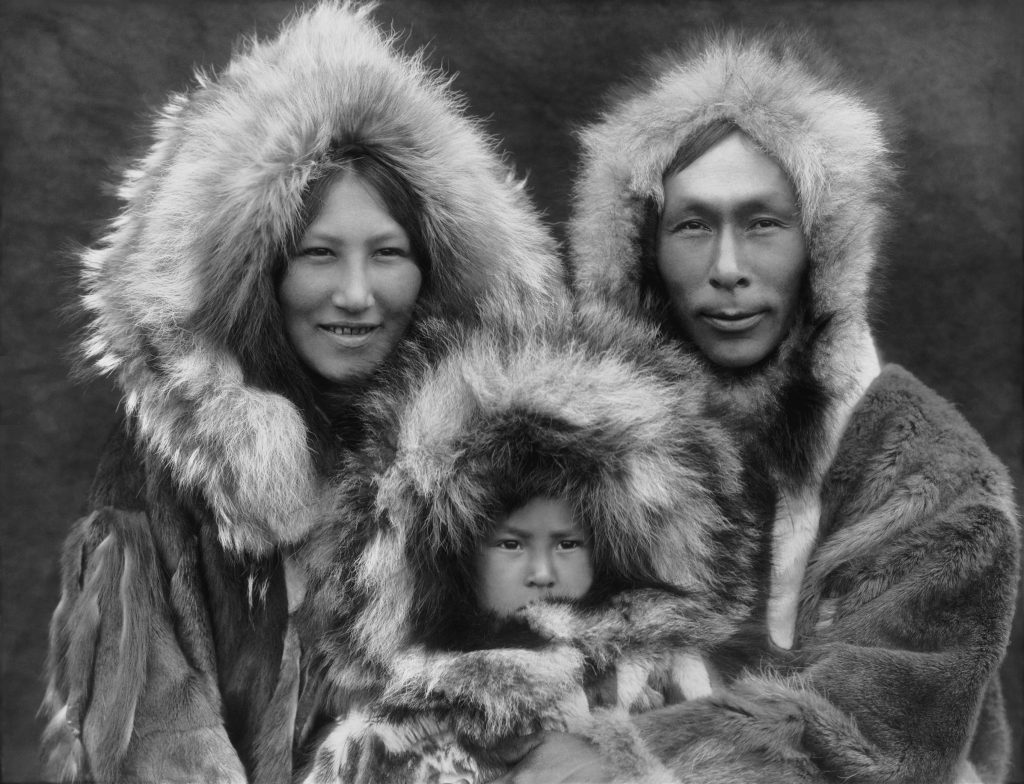
The Eskimo are the indigenous peoples who have traditionally inhabited the northern circumpolar region from eastern Siberia (Russia) across Alaska (USA), Canada and Greenland. Their ancestors crossed a land bridge and reached this land from Asia which no longer exists today.
They traditionally lived by hunting (specially seal) and by fishing. The term ‘Eskimo’ means the people who eat raw meat. Linguists now believe that ‘Eskimo’ is derived from an Ojibura word meaning ‘to net snowshoes’. However, the people of Canada and Greenland prefer another name ‘Inuit’ meaning ‘indigenous people’.
“WBBSE Class 8 General Science Conservation of Endangered Animals, revision notes”
The Eskimo (= Inuit) make their clothes of animal skin. They wear two layers of clothes of Caribou skin. The inner Eskimo layer of fur is against the skin and the outer layer of fur faces out. They also made clothing from other animal skins including dog, squirrel, marmot, fox, wolf, polar bear, bird skin, feathers and seal skin.
Eskimos (Inuits) during summer (when the snow melts) prepare their home made out of Cartoon or Seal skin hung off a frame made of driftwood or whale rib bones. They lived in Igldos the snow house (= snow hut) in the winter. The Igloo was made from hard-packed snow.
They used knives made of bone (now they also use steel) to cut snow blocks (Nowadays Inuit culture has been changed a lot most Inuit people today live in the same community year-round, and live in homes built of other construction materials, that have to be imported).
There are three traditional types of Igloos all of different sizes and used for different purposes.

Chapter 10 Biodiversity Environmental Crisis And Conservation Of Endangered Animals Types Of Igloos
- Smallest Igloo – temporary shelter for one or two nights usually these are built during hunting trips.
- Intermediate-sized igloos –Are semi-permanent family dwellings (single-room).
- The largest igloos Are normally built in groups of two to five rooms. Here several small igloos are attached by tunnels.
Why structure of igloos or tents not made up of wood?
Because there is no trees in the arctic tundra area.
Food :
Eskimos live in such places where hardly few plants can grow. The traditional diet consists of almost entirely meat and fish. They get their food by fishing and hunting. Whales, Walruses, Seals, and fish like Salmons and Cod are the main food.
They also hunt and eat the flesh of ducks, Hares, Polar foxes, and Polar bear. Dogs are indispensable in the life of Eskimos. They use dogs during hunting, pulling Sledge Cars, and also use the smelling power of dogs to identify the hunting animals.
The earth’s north and south poles are known as the end poles lying to the extreme points of the earth. The north pole is the Arctic region which is located in the middle of the Arctic Ocean surrounded by continents on the other hand, South pole comprises of the huge Antarctic continent (ice-covered land) surrounded by oceans.
Chapter 10 Biodiversity Environmental Crisis And Conservation Of Endangered Animals Animal World Of Antarctic Polar Region
In the South pole (Antarctica) Seals, Whales and Dolphins are around with Penguins but Polar bears are absent here. Penguin is not found in the north pole but polar Bear is found there.
- Animals of the North pole (Arctic): Polar bear, Arctic fox, Walrus, Seal, Snow- Owl, White hare, Musk Ox, Reindeer, etc.
- Animals of the South pole (Antarctica): Penguins, Whales, Seals, different sea birds and Krill (small Arthopodes)
- No Penguin in the North pole
- No Polar bear in the South pole
Different types of Penguins are found in Antarctica but among them, the Emperor Penguin is the most remarkable. The Emperor Penguin is the tallest and heaviest of all living Penguins species and is endemic (only found in that place) to Antarctica.
They can live both in ice and water. Its diet consists of fish, krill (small crustaceans) squid. In hunting, they can remain submerged up to 18 minutes and drive to a depth of 535 m (1,755 ft).
Penguins have some special adaptations such as unusually structured haemoglobin allows them to function at low oxygen levels, solid bones to reduce barotrauma (tissue damage due to pressure) ability to reduce metabolism and able to shut down non-essential organ functions.
The female penguin lays one egg (460 – 470 gm) during May and early June during peak winter when darkness and chilling cold descend on Antarctica (Breeding season April to December), After laying the egg the mother’s nutritional reserves are exhausted and she very carefully transfers the egg to the male and returns to the sea for two months to feed.
“Class 8 WBBSE Science Chapter 10 Biodiversity Environmental Crisis, multiple-choice questions”
The male incubates the egg in his brood pouch, balancing it on the tops of his feet. The incubation period last for two months (64 days), [The emperor penguin is the only species where this behavioural peculiarity is observed in all other penguin species both parents take shifts incubating,]
By the time the egg hatches the male will have fasted for a long time (usually not taking any food) (around 115 days). To survive the cold and winds the males huddle together, After hatching (it takes 2-3 days as the egg cells arc very hard) if not the mother rot urn the father penguin feed- the chick a curd-like substance (composed of protein and fat, produce in the oesophagus).
[This ability to produce milk in birds is only found in regions, flamingoes and male Emperor Penguin.] The female Penguin returns of any time after hatching and take care of the chick. The male then go to sea. Both parents take care of the chick. Alternately they doing this unless and until the chick is independently able to hunt (during summer).
The Crisis of Penguin-This unique creature of Antarctica faces serious throats mainly from human activities like overfishing creating their food crisis,use of plastics by explores cause serious damage (sometimes they eat it as food), They are killed for their fat. oil for manufacturing soaps, and fuels.
Penguin feathers for making dresses, shoes, bags etc. To protect these creature International Ornithological Congress urged different nations to protect penguins. In 1959, 12 nations agreed to sign the Antarctica Treaty, This treaty ensured the protection of the Penguin in Antarctica.
Chapter 10 Biodiversity Environmental Crisis And Conservation Of Endangered Animals Environmental Pollution Of Antarctica
Antarctica is one of the cleanest and least polluted places in the earth, It is the ideal location for measuring the spread of global pollutants. Minute traces of man-made chemicals used in other parts of the world can be detected in the snow that falls over the region.
Some facts of Antarctica :
- Earth’s southernmost continent,
- Antarctica is surrounded by the southern ocean.
- 5th largest continent,
- About 98% of Antarctica is covered by ice.
- The average thickness of Ice is 1.9 km (G2QQ ft).
Chlorofluorocarbons (CFCs) and halons are used indiscriminately by human beings for different purposes have reduced the thickness of the ozone layer present over the Antarctica region. For this reason, an ozone hole has been created. Harmful UV (Ultraviolet rays) penetrate the atmosphere of the earth through these holes.
UV radiation can harm humans as well as other organisms by causing skin cancer (man), and cataracts and decreasing the number of different micro organisms living in water that affect the water ecosystem. Increased shipping activities in Antarctica oil-spill, building materials rubbish, metal items, oil and other fuels and plastics in a variety of places in Antarctica also cause hazards.
Birds and seals often engulf some pollutants (plastic, metal, rubbish etc.) leading them to death.
Identify the causes of pollution and how they can be controlled.
Chapter 10 Biodiversity Environmental Crisis And Conservation Of Endangered Animals Conservation Of Wild Life
| Pollution type | Cause of pollution | Effect of these – pollution | Controlling measure |
| 1. | |||
| 2. | |||
| 3. |
Conservation Of Wild Life
We have already seen that human life and its growth depends on different plants and animals in various ways such as food, shelter, fuel, clothes medicine, commercial goods etc. But increasing human population damage biodiversity in many ways- wildlife is being affected seriously.
Environment
The environment is the surroundings in which animals and plants live. Environment influences the life of organisms in many ways.
Habitat
Habitat is the special environment of an organism in which it lives and grows.
This is necessary for the conservation of the habitat of human resources for the existence of human beings as well as its surroundings. Wildlife is important as because it balances the population, maintains the food chain, and natural cycles, and biodiversity controls pollution and prevents soil erosion.
“WBBSE Class 8 Biodiversity and Conservation notes, Chapter 10 worksheet”
Chapter 10 Biodiversity Environmental Crisis And Conservation Of Endangered Animals Causes Of Biodiversity Degeneration
- Habitat destruction
- Deforestation.
- Polluting environment
- Indiscriminate use of natural resources.
- Introduction of exotic species
- Overhunting
- Climate change
- Unnecessary use of different parts of an animal body.
Biodiversity degeneration is a serious threat to human existence. Due to human activity and natural calamities, many animals and plants already extinct some are in the verge of extinction.
The international agency IUCN (International Union for Conservation of Nature and Natural Resources) has published the list of names of endangered animals. The name of this list is called Red Data Book.
In this list different animals have been placed (categorised) at different called levels.
- Extinct—The animals not in earth, the last individual of that species has died, such as Dodo, the Passenger pigeon.
- Extinct in the wild—These animals are not in its natural habitat (wild) and are kept in (a zoo or garden) artificial environment by captive breeding.
- Critically endangered—The animals are in the verge of extinction.
- Endangered—The species are in danger of extinction if the adverse condition remains it will extinct, e.g. Lion tail Macaque, Musk deer, Blue whale.
- Vulnerable—These species are sufficient in nature but their existence is under threat but not extinct soon.
- The lower risk or Rare species—These are the species not facing immediate danger.
- Data Deficient —Data of such species are not clear.
- Not Evaluated —The animal species does not belong to 1 – 6.
Some endangered animals of India are :
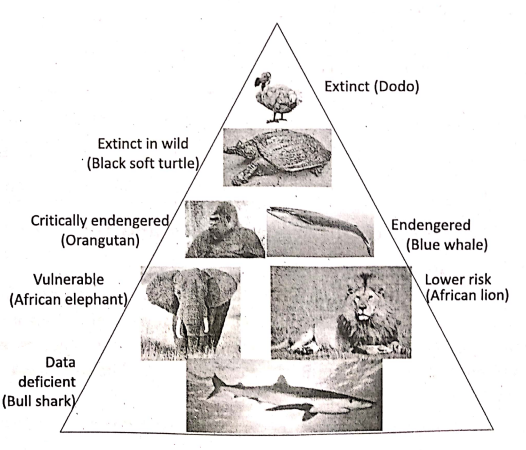
- One-horned Rhinoceros
- Royal Bengal Tiger
- Asiatic Lion
- Wild Ass
- Vulture
- Red Panda
- Snow Leopard
- Gangetic dolphin
- Estuarine crocodile
- Lion-tailed macaque
- Sloth bear
How can Endangered Animals be saved?
Various methods have been taken to save endangered animals in different places of the world. All these methods of saving endangered species are now altogether referred to as a “Gene Bank”.
Chapter 10 Biodiversity Environmental Crisis And Conservation Of Endangered Animals Two Types Of Conservation Are
- In-situ and
- Ex-situ conservation.
In-situ conscrvation-
When endangered animals and plants are conserved in their natural habitats such as natural ecosystems or man-made ecosystems. This involves the protection of natural habitats and maintenance of endangered and other important species by certain protected areas such as national parks, wildlife (natural habitat) or bird sanctuaries and biosphere reserve.
Ex-situ cohservation-
When some animals cannot be conserved in their natural habitat then attempts have been taken to conserve these animals in some distant places like Zoological and Botanical gardens away from their natural habitat by creating favourable conditions.
Besides this microbes, seeds, tissue, cells and genes of plants are also conserved in laboratories (cryo-conservation) from their natural habitat by creating the favourable conditions.
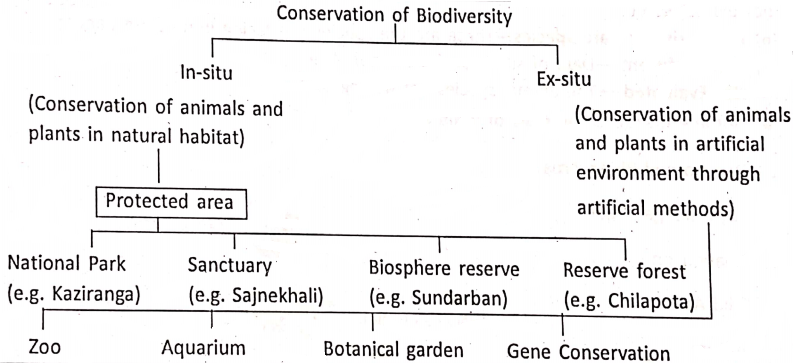
Chapter 10 Biodiversity Environmental Crisis And Conservation Of Endangered Animals Some Endangered Animals And Their Conservation
Vulture :
Vultures are large-sized birds. They feed on dead and decaying animals. They are also known as birds of prey. They have a good sense of smell and sight. Vultures have very strong. bills and claws. The colour of their body is dark brown and they have a slender curved throats without feathers.
They push their elongated throat into the carcasses of dead animals and collect food. Feeding on the carcasses they help to keep our villages and cities clean and hygienic. Shelter—Vulture builds their nests high on the branches of Banyan (Bath), Peepal, Rain- tree, Palmyra, Tamarind, Silk cotton and some species of Fig trees.
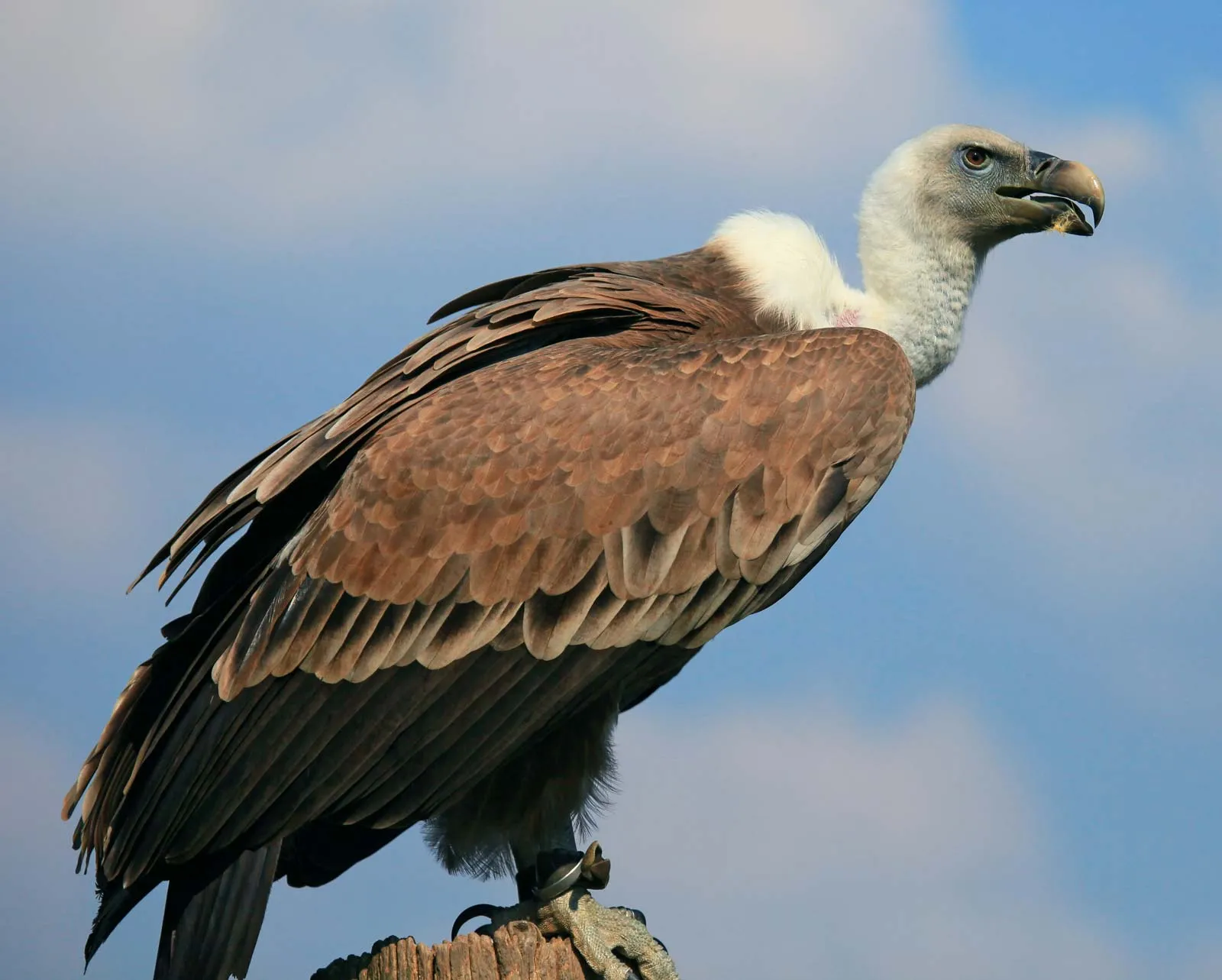
The nest made up of dry twigs and branches are strongly built. Their breeding period is in between September to March. Vulture lays a single egg.
Vanishing Vultures (Vulture crisis) :
India has lost more than 97% of its vulture population in the last about 12 years. Due to this decline, vulture species were listed by IUCN as critically endangered. In 2002 it was also placed in schedule I of the Wild Life Act. According to some experts, the lethal level of the drug Diclofenac is the main cause.
Diclofenac is used as a painkiller for treating animals. It enters the bodies of vultures when they feed upon it. diclofenac—Contaminated carcasses. Vultures are highly susceptible to it. These in their bodies cause gout dehydration and kidney failure and eventually death.
Death may be due to infection of the virus (new strain). Vultures are one of the main causes of aircraft accidents. The increase in air traffic may be one of the reasons for the decline of vultures near aerodromes. Vultures are dying at an alarming rate.
Being keystone species, the decline or extinction of vultures will adversely affect other wildlife, domestic animals and humans too. It can also increase the risk of (epidermic) diseases due to the non-disposal of carcasses etc. Bold and intelligent steps are required to be taken to conserve these wonder fliers and scavengers.
Conservation of Vultures—
The attempt to conserve Vulture has been initiated. India’s Government has banned the use of Diclofenac since March 2006. Several vulture rehabilitation centres were set up in different parts of India. The two most significant such centres are Pinjar of Haryana and Rajabhatakhawa of North Bengal.
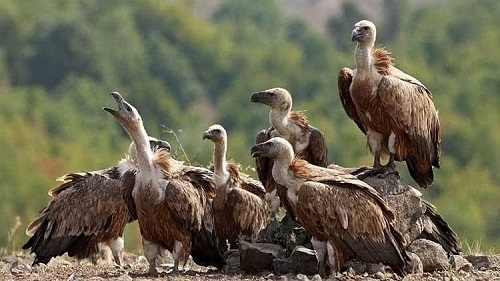
The life span of a vulture is long and the rate of growth is very slow. Therefore, the recovery process needs much time. Now all species of vulture are being conserved under the strict vigilance of the Wild Life Conservation Act.
Chapter 10 Biodiversity Environmental Crisis And Conservation Of Endangered Animals Fishing Cat
The fishing cat Is a medium-sized wild cat of 5outh and South East Asia. Through the distribution of these animals world-wide and have great adaptive abilities. Since 2016 it is listed as vulnerable on the IUCN Red list. Fishing cats are popularly known in Bengal is ‘Baghrole’.
Fishing cat populations are threatened by the destruction of wetlands and declined severely over the last decade.
Fishing cat —Behaviour, habitat and structure :
Fishing cats are usually nocturnal. They are very much at home in the water and can swim long distances even underwater. Birds, insects, small rodents, molluscs, reptiles, and snakes are their main diet. Fishing cats is larger than a domestic cat.
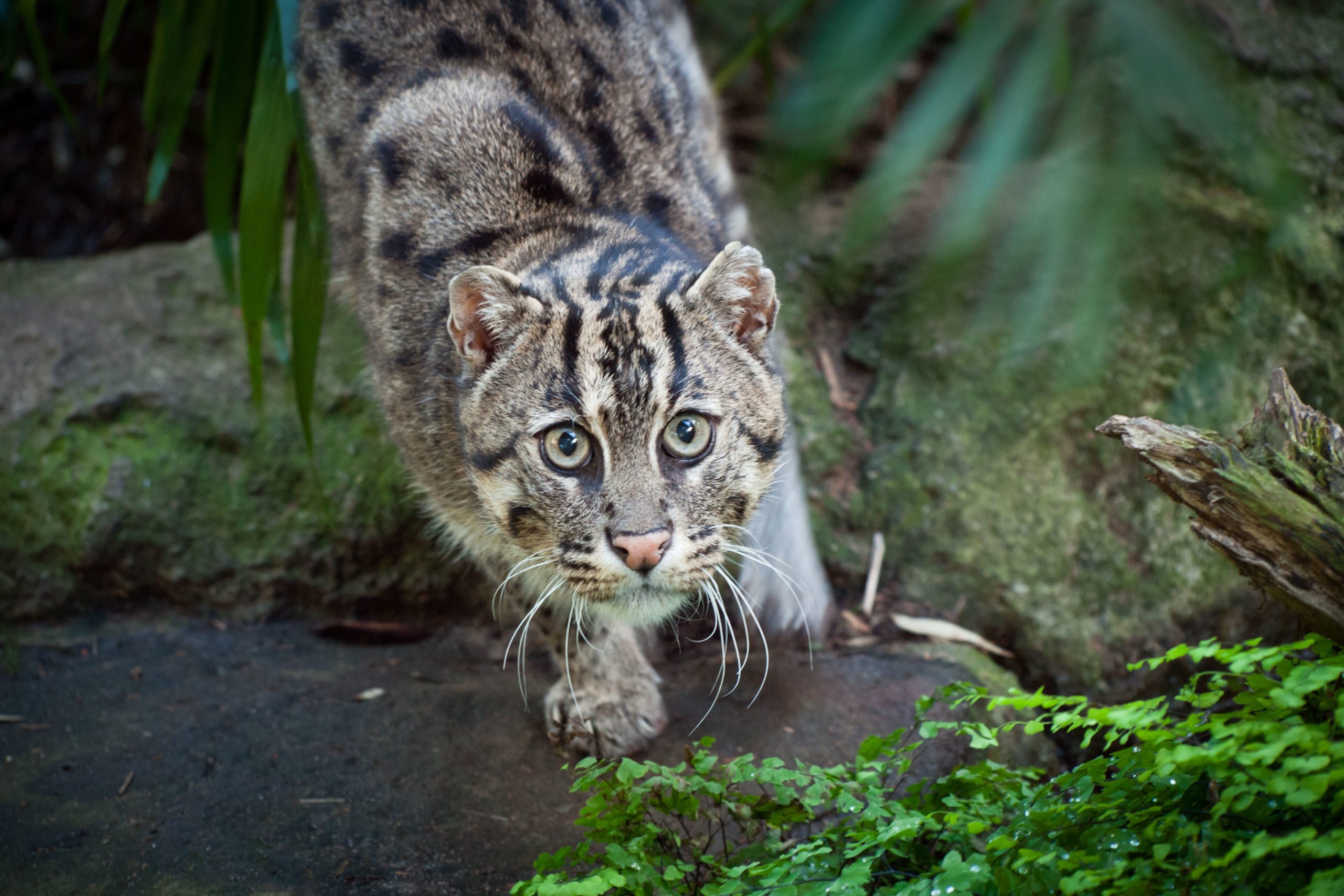
They have a deep-chested body with short legs and big broad heads and short tails. Fishing cat (Baghroie) There are elongated dark brown spots arranged in longitudinal rows extending over the entire body. There are six to eight dark lines running from the forehead to the neck and the underparts are whitish and spotted.
The fishing cat is well adapted to catching fish, their front feet are partially webbed and their claws are incompletely sheathed so that they protrude slightly when reacted.
Crisis and conservation of Fishing cats:
Fishing cats are widely distributed but concentrated primarily in wetland habitats, which are increasingly being settled degraded and converted. They are typically found in a number of water habitats, mangrove swamps and densely vegetated areas along rivers and streams.
The habitat and source of natural food of fishing cats are decreasing day by day. So nowadays they are being compelled to intrude into human habitat in search of ducks and hens.
They are also being killed by humans. If we fail to keep their natural habitat and food products these animals will extinct in near future.
Chapter 10 Biodiversity Environmental Crisis And Conservation Of Endangered Animals Gangetic Dolphin
Habits, Habitat and structure o? Gangetic Dolphin. The Gangetic Dolphin is a freshwater aquatic mammal that lives in the river Ganges Ganga and Brahmaputra river and their tributaries. The Ganga river Dolphin or Susu lives in one of the most densely populated regions on the world.
One of the main threats to the species is loss of habitat due to a large part to the river loss by the creation of dams and irrigation projects. The Ganges river Dolphin has been recognised by the Government of India as Its Nationa Aquatic Animal.
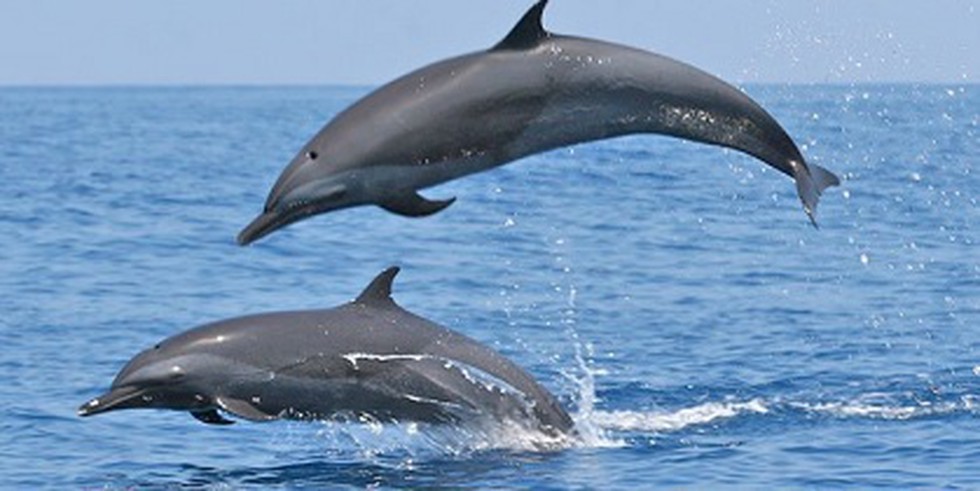
Gangetic Dolphin can be easily identified by their long thin snout (rostrum) (long pointed nose) with visible teeth in both the upper and lower jaws even when the mouth is closed, rounded belly, steam line body and two front legs are modified into large flippers, the tail is flattened dorso-vcntrally (top and bottom).
The colour of the Dolphin is greyish-brown or deep black in colour. The middle parts of the body is thick and two ends are pointed. Their skin is hairless. A layer of fat (blubber) under their skin, keeps their body warm even under water.
The two lips in front of the mouth are protruded like a beak. In each jaw there are 27 — 32 small similar teeth, (There is no varieties of teeth) Nasal orifice is elongated and situated at the tip of the beak. They can open or close this orifice as their will. Although they are aquatic they inhale aerial oxygen by coming to the surface of the water.

The head and the body cannot be separately distinguished due to the absence of a neck. They do not have an eye lens (crystalline lens) that blinds the dolphin yet they are able to detect the intensity and direction of light.
Dolphin has a strong sense of smell.
The dolphin has the peculiarity of swimming on one side so that its flipper trails the muddy bottom this behaviour is understood to help it to the food.
Navigation
Navigation(feeling the direction) and hunting are carried out using echolocation. The animal emits some sounds with the help of organs namely the dorsal bursa present in the nasal cavity. That travel and return after getting obstructed by any object.
Dolphins understand what lies ahead from far it is by hearing the echo. The Gangetic Dolphins are carnivorous. They hunt the animal that hides in the muddy bottom of the river by echolocation.
Fish and different aquatic invertebrates like prawns are their food. After detecting their prey they use the long snout (rostrum) to get hold of the prey.
The crisis and conservation of Gangetic Dolphins:
Excessive contamination in Ganga is a serious threat to the survival of aquatic life there. The increasing level of industrial effluents sewage and pesticides are causing harm to the critically endangered, Gangetic dolphin.
Shortage of small aquatic animals like fish and other invertebrates causes a food crisis of dolphins. The depth of water in the river is decreasing due to the construction of dams and other reasons. Communication between different groups of dolphins are lost.
Small and segregated dolphin groups face breeding problems. Sometimes they die being entrapped in fishing nets. Vikramshila Gangetic Dolphin Sanctuary has been set in 1991 in Bhagalpur, Bihar. It is a protected area for the endangered Gangatic Dolphins in Asia. ‘
An awareness campaign for Dolphin conservation has been started among the fishermen. WWF-India also had started the Dolphin conservation programme to conserve the habitat of the Ganges River Dolphin and secure a future for this endangered species.
Chapter 10 Biodiversity Environmental Crisis And Conservation Of Endangered Animals One Horned Rhinoceros
Habit, Habitata ahd Structure
The Indian Rhinoceros (Rhinoceros unicorns) is also called the greater one-horned Rhinoceros or Great Indian Rhinoceros. This species of Rhinoceros is native to the Indian subcontinent. Now it is found only in the forests of Assam and North Bengal. This is one of the critically endangered animals of the world.
The Indian Rhinoceros once ranged through out the entire stretch of the Indo-Gangetic plain but excessive hunting and agricultural development and new human habitation reduce their range drastically.
Structure :
The Indian Rhinoceros has thick (same places 4 cm thick) grey-brown hard skin with pinkish skin folds and a black horn. The body is hairless except on the tip of nails, horn around the ears and on eyelids. Its upper legs and shoulders and in front of the thigh have hard covering like armours.
There is a thick layer of fat (2 – 3 cm) below the skin. The external ears of the Rhinoceros is roundish and spread. At the side of their body above skin, they have big tubercles.

The Rhino’s single horn is present in both males and females (about 60 cm long) but not in newborn young. The horn is made up of pure keratin, Its a protein, and nail and hairs are also made up of this protein. Horn appears to show after about six years. If the horn breaks for any reason, it regenerates.
The Rhinoceros uses its horn to search for food like digging the soil or finding out the roots of trees. Apart from this they use the horn to fight other male rhinos during the breeding season. They live mainly in the Jungle of tall grasses near flooded plains or wetlands. Rhinoceros usually lives alone with the exception of breeding pair.
They usually move around mostly during early morning, dusk or at night. They take rest in the shade of trees when sun is in high. Rhino is second in size among terrestrial land mammals after elephants. They usually covered their bodies with mud which helps to make the body cool.
This mud coating also protects the body from different insects and parasites. Anthrax is a bacterial disease which usually affected Rhino. Rhinoceros are basically herbivorous. They feed on tall grass or aquatic plants and even fruits.
The adult rhino urinates up to 3-4 metres backwards when irritated. The incisor in the lower jaw is very long. The Indian Rhinoceros has the curious habit of defecating at the same place. Since the defecate at the same place, the dunghill grows in height.
After reaching a height they create a new dunghill. The hunter or preacher of Rhinoceros waits near dunghill because of the habit of Rhino.
Chapter 10 Biodiversity Environmental Crisis And Conservation Of Endangered Animals Role Of Rhinoceros In Grass Land Echo System
- The Indian Rhine digs up the soil with their horn. These open up the possibility of germination of a new type of seeds. Enrich the forest density as well as helps to grow more herbivores.
- Indian one-horned rhinoceros feed on different types of food. They defecate in the same place and when it is raised a certain height the rhino level it with their horn. The excrete contain nutrients seeds of rhino-dung germinate a few days after an#birds take away some of these seeds to other places dispersal of seeds occurs.
Crises and Conservation of Rhino :
Rhinos are facing a severe crisis and unless something dramatic is done to protect them they will go extinct in the wild. In June 2014 the first successful live birth from an artificially inseminated rhino took place.
Once the Rhinoceros spread over the entire Eastern region of the Indian sub-continent now restricted to one or two pockets. The life span of a Rhinoceros is 35-45 years.
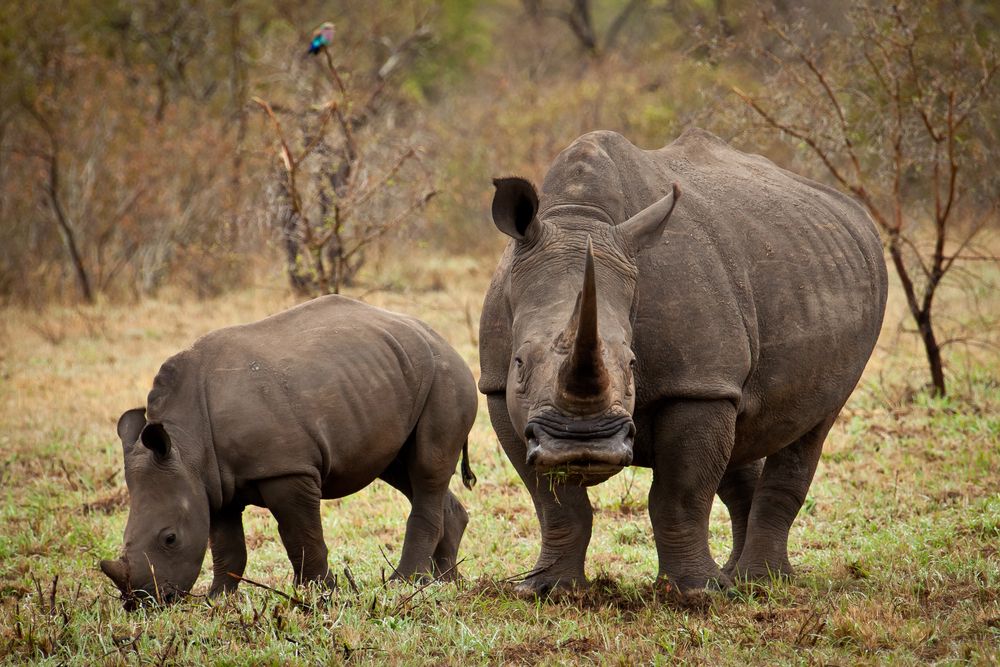
This is due to the loss of their habitat and they fall prey to the greed of poachers due to a wrong belief that the horn of rhinoceros has medicinal or stimulating properties. These beliefs do have not any scientific proof.
Presently single horn rhinos can only be seen in the Indian subcontinent in the Brahmaputra basin in Assam (Kaziranga, Manas etc.) two national parks of West Bengal (Jaldapara and Gorumara) Dudhwa reserve forest (Up)(Rhinoceros reintroduce in 1984) and also in Chitwan National Park of Nepal.

